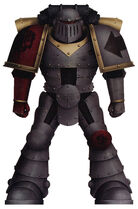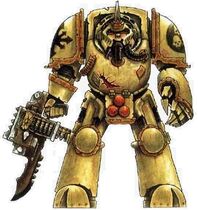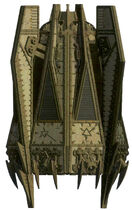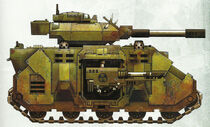"In the embrace of great Nurgle, I am no longer afraid, for with His pestilential favour I have become that which I once feared: Death."
- — Kulvain Hestarius of the Death Guard
The Death Guard are one of the Traitor Legions of Chaos Space Marines. They worship and devote themselves exclusively to the Chaos God Nurgle and as a result of his mutational "gifts" they have become Plague Marines; Astartes who are eternally rotting away within their Power Armour and infected with every known form of disease and decay but who are immune to all pain or minor injury. When the XIV Legion was first raised on Terra by the Emperor, its Astartes were known as the Dusk Raiders. After the XIV Legion was reunited with its Primarch Mortarion on the world of Barbarus, he renamed the Legion the Death Guard.
Legion History
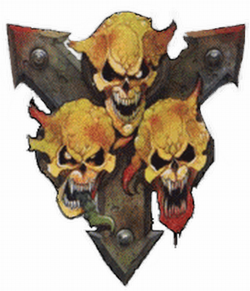
Post-Heresy Death Guard Legion Badge
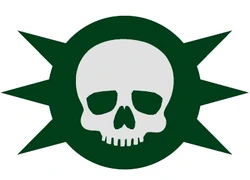
Pre-Heresy Death Guard Legion Badge
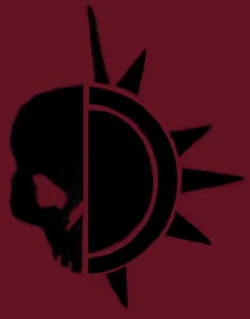
Pre-Heresy Dusk Raiders Legion Badge
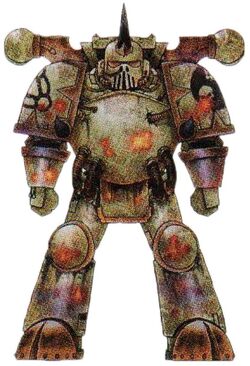
Death Guard Legion Colour Scheme
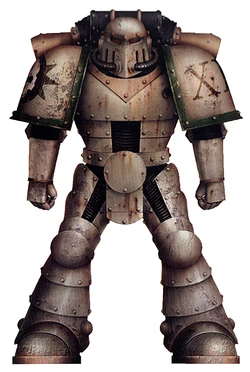
Pre-Heresy Death Guard Legion Colour Scheme
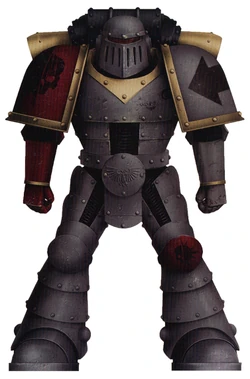
Pre-Heresy Dusk Raiders' Legion Colour Scheme
The Emperor of Mankind sought to unite all of humanity under one banner following the Long Night of the Age of Strife, and end inter-human conflict. Once united, the Emperor intended to begin the next stage of His great plan to ensure human domination of the Milky Way Galaxy, which He judged to be necessary if humanity was to survive the never-ceasing threats to its existence embodied by Chaos, myriad xenos races and its own fragile human nature. In time, when the Emperor's eye first began to fall beyond Terra, He began to raise new armies to fight his Great Crusade. He drew these new troops in part from the forces that had already unified Terra during the Unification Wars of the late 30th Millennium. To carry out the Great Crusade and reunite all the scattered colony worlds of Mankind beneath the single banner of the Imperium of Man, the Emperor created the genetically-enhanced superhuman warriors known as the Space Marine Legions. These forces would serve as the speartip of his Great Crusade that began in ca. 800.M30, bringing the light of Imperial Truth and enforcing Imperial Compliance with the new regime on every human world encountered.
Warlords of Dusk
The origins of the Dusk Raiders can be found during the Unification Wars. The base human stock for the majority of the first Space Marine Legions to be raised came from Terra, and in the case of the XIV Legion the main bulk of the gene-recruits used were drawn from the ancient and warlike clans of Old Albia, situated in the area of southeastern Europe near what had once been the ancient nation-state of Albania. Indeed such was the suitability of this stock for induction into the ranks of the Space Marines that recruits drawn from their Castram-cities were also to be found in the ranks of the First Founding VIII and X Legions, the Night Lords and the Iron Hands, respectively, although to a lesser degree than the XIV Legion who were by blood and culture shaped by the traditions of the warlords of Albia as well as the hand of the Emperor.
The recruitment of the sons of Albia served a twofold purpose; firstly, and most importantly, it drew off the cream of whole generations of strength from a Terran realm, now friend and ally to the Imperium but never fully trusted. For Old Albia, towering amid the northern Atlan wilderness, had once been a true rival of the Emperor for control of the destiny of Mankind. By recruiting their brightest and best into the Legiones Astartes and the other growing Imperial organisations marked for war amid the stars, the Emperor ensured they could never threaten the Unification from within. Secondly, it subsumed into the Emperor's forces all the martial traditions and bloodlines that had for centuries held much of Terra under their cruel grasp and had eventually overcome the Panpacific Empire under the rule of its Unspeakable King, Narthan Dume. Such a breed of relentless warlords and soldier-scientists was an invaluable resource that the Emperor was loathe to waste.
By the time the Unification Wars had begun, the warlord clans of Old Albia had thrown off the tyranny of the last descendants of the Unspeakable King, and did not readily bend their knee to the Emperor, for they refused to have another master in Dume's place. Instead the Albians met the Emperor's regiments of Thunder Warriors with their own battalions of steam-belching proto-Dreadnoughts and heavily armoured Ironside soldiers. In battle after battle, the forces of the Unification were held in check, although at a shattering cost for the Albians, who would not give in despite the Imperial onslaught. Impressed with the Albians' martial temper and indomitable courage, the Emperor called for a ceasefire and sought victory over the warlord clans through peaceful negotiations, understanding that to crush them by force alone would entail a grinding war of attrition that would only serve to decimate His own forces and gain Him naught but a handful of ashes as a prize of war.
The Emperor pursued peace despite the protestations of his human counsellors and generals. Going before them, it is said, unarmed and clothed in white and crimson, the Emperor spoke to the warlords' parliament and laid before them his vision of a future Mankind reunited and ascendant, of tyrants toppled and nightmares slain. He offered them glory amongst the stars and most importantly, redemption for many hundreds of years of kin-slaying and bloodshed. To the shock of many, the warlords of Old Albia accepted the Emperor's vision. In doing so, the Albian clans became among the Unification's most zealous supporters, although still untrusted by many, lending their warriors and secrets long kept up for the Emperor's eyes alone. Most importantly for the future of humanity, the Albians sacrificed their sons to become the first Space Marines.
The XIV Legion quickly developed in the use of tactics and methods of warfare that their Ironside forebears would have found utterly familiar, matched with a stoic temperament and gene-crafted aptitude which few doubted had been the Emperor's design all along. Operating in the role of heavy infantry, the Astartes of the XIV Legion were experts at survival and endurance, and quickly gained a reputation among the other newly-forged Legions as relentless and disciplined fighters. In defence they were stubborn and indefatigable, able to stand unwaveringly against the heaviest fire and hold their position against all comers to the last living body and Bolter shell if needed. In attack they systematically destroyed a given target, crashing upon an enemy in wave after wave of armoured bodies, excelling in close range fire-fights and bloody attrition. Their grey and unadorned Power Armour began to carry the symbols of rank and decoration, now modified that once formed the armorial imagery of the Ironsides of Old Albia, and most tellingly their right vambraces, gauntlets and shoulder plates were painted the deep crimson of drying blood, now symbolising the red right hand of the Emperor's justice where once it had proclaimed the murderous reach of the Panpacific Empire's Unspeakable King.
As the XIV Legion fought in the last days of Terran Unification and the first battles of the Great Crusade off-world, they were given the epithet of "Dusk Raiders" by those they fought and took it for their own. This name was a consequence of their use of the ancient Albian tactic of conducting major ground attacks at fall of night when the shift of light confused an enemy's watch, and gathering darkness would shadow an advance across open ground. Such was the reputation the XIV Legion garnered, in fact, that foes given an ultimatum of attack by the Dusk Raiders would often waver in their resolve, their soldiers panicking and deserting their bastions or throwing down their arms and fleeing at the coming of darkness rather than face the Astartes. As relentless as they were in attack, the Dusk Raiders were known to be honourable opponents as well, who would hold to bargains struck for early surrender and honour symbols of truce. When such terms lapsed, however, and the die was cast for destruction, it was just as widely known that nothing would stay the Dusk Raiders' hand. Such honourable terms only extended to human foes worthy to be brought into the fold of Imperial Compliance, however; to the degenerate, the mutant and the alien, no such mercy was given.
So the Dusk Raiders continued this course over the next eight standard decades as they fought on unwavering in the service of the Great Crusade. Still fatherless during this time as other Space Marine Legions gained their long-lost Primarchs until only a handful remained to be discovered, this "orphan" status further bred a self-reliance and a quiet, stubborn pride in the Dusk Raiders' self-forged character, and the martial triumphs of the XIV Legion were many and enviable. Their reuinification with their Primararch though, when it finally came, was not to be the happy event that many had long hoped for, but instead it was to be a pall that fell across the Legion, and under its shadow the Dusk Raiders were broken down and remade, and only the Death Guard remained.
The Death Lord

When the 20 gestating Primarchs of the Space Marine Legions were scattered across the galaxy through the Warp from the Emperor of Mankind's secret gene-laboratory deep beneath the Himalayan Mountains on Terra in a mysterious accident likely caused by the Ruinous Powers of Chaos, one came to rest on the planet Barbarus, a Feral World located in the Segmentum Tempestus that was wreathed in poisonous fog. The population of the world was split into two groups: the controlling warlords who were necromancers who possessed fantastic psychic powers, along with the human settlers, who had been trapped on the planet millennia before and were now forced to eke out an existence in the poison-free valleys of the planet, fearing the wrath of the warlords and their undead and mutant creations. The Primarch-child was taken in by the most powerful of the warlords, who found him amongst the corpses of a battlefield, screaming and wailing where a normal child would have suffocated and died long before. The Overlord of Barbarus took the child in with the intention of creating a son and heir, naming him Mortarion - the child of death.
Mortarion was kept in a fortress positioned at the limit of even his superhuman tolerance to the toxins in the air, while the Overlord moved his own manse to the highest peak of the world, beyond where even Mortarion could go. He trained the child, who had a highly keen intellect and voracious appetite for knowledge; Mortarion learned everything from battle doctrine, to arcane secrets, from artifice to stratagem. However, the young Primarch's questions began to turn towards subjects the Overlord did not want to talk about, namely the pitiful creatures in the valleys that the many warlords preyed upon for corpses to reanimate and bodies to corrupt.
The Deliverance of Barbarus
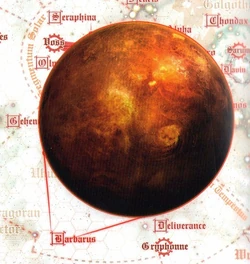
Ancient Departmento Cartographicae map indicating the location of Barbarus in the Segmentum Tempestus
Finally, knowing he would be unable to find the answers he desired from his adoptive father, Mortarion broke out of the fortress that had been his home and prison after killing several guards stationed at the gates of the fortress, and headed for the valleys of Barbarus. Breaking through the poisonous mists, Mortarion discovered that the prey of the warlords were in fact the same species as he, and swore to deliver them from their oppression. The people of Barbarus were slow to accept this pale, gaunt stranger from the mountains, but Mortarion was given a chance to prove his worth when mutant creatures enthralled to another warlord attacked the village. Seeing that the peasants were unable to effectively fight back, Mortarion joined the fray, wielding a massive harvesting scythe that made short work of the beasts. The warlord smiled when Mortarion advanced upon him and withdrew to the apparent safety of the deadly fog, only to be pursued and butchered by this inhumanly resilient Primarch. Accepted into the village without further reservation, Mortarion began to train the villagers in the art of warfare. Soon, representatives from other villages journeyed to learn from Mortarion, while the villages scattered across the valleys of the world were transformed into strongpoints. Mortarion travelled from settlement to settlement, teaching, building and defending his people.
He recruited the toughest, most resilient men he could find, forming them into small units that trained under his supervision. He enlisted the aid of blacksmiths, craftsmen and artificers to create special suits of armour that would allow men to travel through the poisonous fog. As each battle in the mists was fought, Mortarion and his Death Guard would learn how to better adapt the armour, and themselves, to reach the more poisonous heights. Eventually, only one peak denied them access, the one on which Mortarion's adoptive father had made his home.
The Coming of the Emperor
Despite his adoptive father being a ruthless necromancer, Mortarion felt reluctant to attack the man who took him in and called off the planned attack. Returning to the village, Mortarion's mood darkened when he found his people talking not of his victory but of the arrival of a benevolent stranger who promised salvation to the people of Barbarus. Finding this stranger in conference with the village elders, Mortarion claimed that his people needed no outside help. The stranger commented that even Mortarion and his Death Guard were having trouble pacifying the final warlord, and offered a challenge. If Mortarion could defeat the Overlord, the stranger would leave. If not, Mortarion had to swear fealty to the stranger and the Imperium of Man he represented.
Ignoring the protests of his Death Guard, Mortarion left alone to confront his adoptive father, motivated by a compulsion to prove himself to the stranger below. The confrontation was brief. The air surrounding the Overlord's fortress was so poisonous, that parts of Mortarion's armour began to rot. He collapsed at the gates of the Overlord's citadel, bellowing challenges. The final thing Mortarion saw before he passed out was the Overlord of Barbarus coming to kill him, then the stranger leaping between the two and slaying the Overlord with a single sword thrust.
When he recovered, Mortarion swore fealty to the stranger, who revealed himself to be Mortarion's father, the Emperor of Mankind. The Emperor granted Mortarion command of the XIV Space Marine Legion, then known as the Dusk Raiders, who quickly adopted the name and regalia of Mortarion's Death Guard. However, the Emperor's slaying of his adoptive father proved to be a grudge Mortarion long held against his true father, for he had desired above all else to end the tyrant's life himself. When the Emperor took this chance to earn vengeance away from Mortarion, a seed of hatred and blame was placed within his heart that would in time blossom into rank betrayal.
A Mournful Unity
True to his oath, Mortarion bent his knee to his new-found father as soon as he was sufficiently recovered to do so, although his final act of defiance on Barbarus would leave scars upon him both physical and mental that would never fully heal. A skilled warlord in his own right, Mortarion was immediately given command of the XIV Legion which carried his genetic inheritance, and did so on his own terms. Gathering them before him, a grim and spectral figure robed and bearing the great black scythe that had once belonged to his nightmarish foster-father, it must have seemed to the Terran-born Dusk Raiders that an ancient, graven image of the Grim Reaper had come before them as their new master. His words were simple and delivered in a harsh whisper that never the less carried to each and every one: "You are my unbroken blades. You are the Death Guard. By your hand shall justice be delivered, and doom shall stalk a thousand worlds." The Legion's name was then changed in accordance with this decree, and Mortarion's words were engraved above the airlock door of the Battle Barge Reaper's Scythe in honour of that moment. By this simple decree the Dusk Raiders were no more, and the records and annals from that day forward would carry this new name as one to strike fear into the hearts of Mankind's enemies.
The XIV Legion's Astartes had been primarily Terran-born before Mortarion joined the Legion; after that time almost all of the Legion's Neophytes were drawn from the Feral World of Barbarus. This changed the culture and traditions of the Legion, so much so that by the last days of the Great Crusade in the early 31st Millennium, there were increasing tensions between the Barbarus-born Astartes and the Terran minority who remained in the Legion and who remembered the Dusk Raiders' earlier martial traditions brought out of Old Terra. These tensions became most clear in the period directly preceding the first battle of the Horus Heresy at Istvaan III, when approximately one-third of the Legion was judged by Mortarion to be likely to remain loyal to the Emperor when the Legion joined the Warmaster Horus in his rebellion against the Imperium. Many of these Loyalist Death Guard Astartes were Terran-born, former Dusk Raiders like Battle-Captain Nathaniel Garro of the 7th Great Company whose loyalty to the Emperor outweighed their devotion to their Primarch.
The Great Crusade
"Say what you like about the Fourteenth Legion. They are mean, ugly bastards but tenacious. There's no one else I'd rather have by my side in a war of attrition, and almost anyone else I'd rather have against me."
- — Ferrus Manus, Primarch of the Iron Hands Legion, after the compliance of One-Five-Four Four
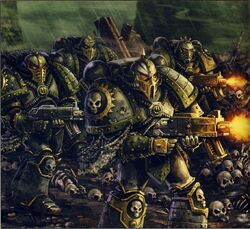
Death Guard Tactical Squad brings a world into Imperial Compliance during the Great Crusade
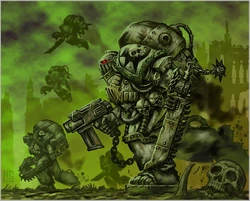
Death Guard Assault Squad spearheading an assault on a poisonous planet
In the decades that followed the renamed XIV Legion fought tirelessly in the service of the Great Crusade, never relenting in battle beneath their Primarch's gaze they pursued the liberation of Mankind with a fervour the Great Crusade had never known. Their restless fleet ploughed the cold void from one campaign to the next, resupplying on the move, never pausing but to make war. The Death Guard did not garrison, they did not build, they only tore down and slew, coldly, determinately and with the inexorable progress of a contagion or a tsunami wave, and worlds fell before them.
Over time Mortarion shaped the creed and practice of the Death Guard, his beliefs in many ways forming a natural extension of their own, beliefs and doctrine becoming ever more refined and extreme. At the heart of them was the unshakeable determination that Mankind should be free of oppression and terror. Such freedom could only be won in the Primarch's mind by destroying those that would shackle and devour humanity. This was a war to be fought without mercy or limit, without restraint or relenting. The battle for the human future was one that could only be won by enduring any hardship, no matter how terrible, and not shirking from any act, no matter how savage in pursuit of victory. This single end, the liberation of humanity to Mortarion's creed, justified any means.
The Inheritance of Barbarus
Decades of endless battle changed the Death Guard, and over time the Terran influences on the Legion became less and less apparent, with the panoply and traditions of the Dusk Raiders and the Officio Militaris erased in favour of Barbarus' bleak creed of war. The bare ivory-grey unpainted ceramite that Mortarion favoured for the Legion's Power Armour became increasingly less adorned, save for new murky-jade markings set to echo the corrosive-resistant swamp mud applied to coat the iron plates of the human warriors that had once served the Primarch of Barbarus, and shorn of older heraldry and Terran influence. The martial stratifications of Old Earth's warmasters were done away with too, and eventually the Legion's Librarius was disbanded thanks to Mortarion's hatred of witchery such as that the hated charnel masters of Barbarus had once wielded.
Mortarion's hand and mind was at work everywhere remaking his Legion, from changing tactical doctrines to equipment procurement and, some say, behind the selection of candidates and changing practices in the Legion's Apothecarion, where he gained the latter knowledge to interfere. With the prevailing conditions on Barbarus and the foul beings that more than likely still stalked the planet's fog-shrouded mountains and deep swamps, there were whispers that the human population that remained would have been better off if they had been euthanised or displaced to a "cleaner" world for the sake of the sanity of future generations. Mortarion would have none of this, for Barbarus now belonged to his people, bought and paid for by generations of blood and terror, and its strongest sons would now serve as recruits for his new Death Guard.
As for the purely human Death Guard that had once fought for him against the overlords of Barbarus, many now became the masters of that world and a dread aristocracy they soon became, while the youngest and strongest took full or partial conversion into the Legiones Astartes, heedless of the high fatality rate that late induction carried with it, deemed a small enough price to pay to continue in the service of Mortarion their saviour. With new recruitment at issue, Barbarus itself in a short span of years became little more than a factory of sorts to produce new recruits for the Death Guard Legion, and intake from other sources of recruitment to which the Legion had title dwindled to a mere handful, unless the pressure of fatalities in the field proved too great. Mortarion's resistance to the use of bloodstock other than that of Barbarus wavered only because of the need to keep his Legion's strength battleworthy in his eyes. Recruitment solely from Barbarus was however aided by the high suitability of the planet's hardy feral population to the conversion process. The Legion's gene-seed seemed to amplify the uncommonly resistance to contagion and toxins in its Barbarus candidates to unheard of levels.
As fresh intakes of new Space Marines came in from Barbarus, the surviving core of Terran blood became a minority as the Great Crusade burned on across the stars, the Death Guard at the forefront of the fighting in the most hellish war-zones imaginable. Although second perhaps in their father's eyes, the Terran contingent remained stubborn in the ranks, hardened veterans and a force to be reckoned with in the Legion. With the Legion drawing the majority of its Neophytes from Barbarus, this changed the culture and traditions of the Legion, so much so that by the last days of the Great Crusade in the early 31st Millennium, there were increasing tensions between the Barbarus-born Astartes and the Terran minority who remained in the Legion and who remembered the Dusk Raiders' earlier martial traditions brought out of Old Terra. These tensions became most clear in the period directly preceding the first battle of the Horus Heresy at Istvaan III, when approximately one-third of the Legion was judged by Mortarion to be likely to remain loyal to the Emperor when the Legion joined the Warmaster Horus in his rebellion against the Imperium. Many of these Loyalist Death Guard Astartes were Terran-born, former Dusk Raiders like Battle-Captain Nathaniel Garro of the 7th Great Company whose loyalty to the Emperor outweighed their devotion to their Primarch.
The Horus Heresy
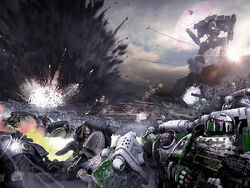
The first battle of the Horus Heresy begins on the surface of Istvaan III
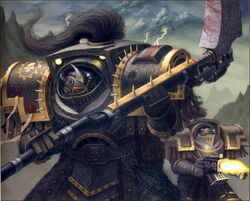
First Captain Calas Typhon of the Death Guard Legion
Mortarion believed that victory in battle came through sheer resilience, and Horus, who used the strengths and weaknesses of the different Legions to create the most efficient fighting force possible, used his Legion in co-ordination with Mortarion's frequently. Mortarion and the Death Guard would draw out the enemy and tire them down, and then the Luna Wolves would strike. This combat tactic worked brilliantly, and Mortarion grew close to Horus. The Lord of Death was a grim and driven Primarch, his breathing apparatus and scythe an inseparable component of his aspect. The pallid, hairless Primarch was viewed by others as a freak, and was distant from all his brother Primarchs save the Warmaster Horus and Konrad Curze, the Night Haunter. Some even whispered that Mortarion was more loyal to Horus than he was to the Emperor; however the Emperor claimed that loyalty to Horus was de facto loyalty to the Emperor, for the two were that close. Events would prove the Emperor sorely mistaken.
When Warmaster Horus turned to Chaos, it did not require much effort to drag Mortarion and his Death Guard Legion down with him. Horus had been one of the few Primarchs with whom Mortarion had felt comfortable, and as such he showed more loyalty to the Warmaster during the Great Crusade than to the Emperor himself. In addition to this, First Captain Calas Typhon, Mortarion's right-hand man, had long been a secret follower of the Ruinous Powers and eagerly manipulated the rest of the Death Guard into treading the path of damnation. Mortarion revealed his true colours during the scouring of Istvaan III, when he willingly sent potentially Loyalist elements of the Death Guard into Horus' trap. Once the Astartes who remained loyal to the Emperor were purged, the Death Guard then fought alongside their Traitor brethren during the Drop Site Massacre on Istvaan V.
The Doom of the Death Guard
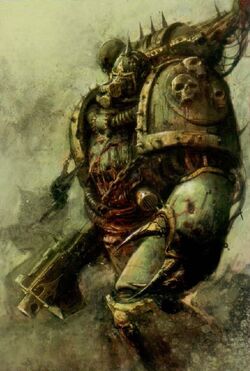
A Plague Marine of Nurgle
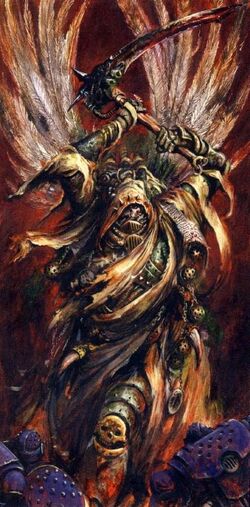
Mortarion the Prince of Decay, Daemon Prince of Nurgle
During the subsequent assault on Terra itself, the Death Guard were part of Horus' invasion force. However, enroute, the entire Death Guard Fleet became trapped in the Immaterium due to the actions of First Captain Calas Typhon, trapping them in a perpetual nightmare.
It was whilst on campaign with the Word Bearers Legion earlier in the Great Crusade that Typhon had learned of a different path for the Legiones Astartes to follow, a future where his hard-won but hidden psychic abilities would be a source of greatness instead of a taboo to be hidden from sight. The foremost Chaplain of the Word Bearers, Erebus, inducted Typhon into the secrets of the Seven Pillared Lodge, one of the Warrior Lodges that had begun to spread throughout the Space Marine Legions in the later days of the Great Crusade. It was during this time that Typhon caught a glimpse of what the Space Marines could truly become if they shrugged off the yoke of the Emperor's ambitions.
Perhaps Typhon's revelation was instrumental in Mortarion's own fall to the Ruinous Powers; perhaps Mortarion would have walked a dark path on his own. Either way, the troubled Death Guard Primarch saw a worthy master in Horus, whereas in the Emperor he saw only a self-serving and pompous pretender who had stolen Mortarion's hard-won kingship in a single day. As the heresy that Horus initiated slowly but surely escalated into a galactic civil war, Mortarion ordered his fleet to head for Terra with all haste, intending for the Death Guard to join the other Traitor Legions in the destruction of the False Emperor. By this point, Calas Typhon served one master alone, and it was not his Primarch. Typhon had seen to it that the fleet's Navigators were killed to a man, but reassured Mortarion that the Warp-gift he possessed would see them through their journey in the Empyrean safe enough. Though he hated the concept of relying on witchery, Mortarion was left with little choice. The Death Guard fleet made transition into the Warp, and in the process damned themselves to an eternity of war as the puppets of a foul and ancient god.
In leading the Death Guard into the Warp, Typhon had delivered them into the clutches of his new master, Nurgle, the Lord of Decay. The strange tides of the Empyrean are notoriously fickle, and during their voyage the entire Death Guard fleet was becalmed. As their warships lingered, directionless and without hope, the cloying influence of Father Nurgle began to take hold. The Death Guard were subjected to the terrible infection of the Destroyer Plague and Nurgle's Rot, as Nurgle's power managed to infiltrate the vessels of the XIV Legion. It polluted the vessels themselves as easily as it did the transhuman warriors within. Before long, fat devil-flies buzzed through the thickening miasma inside each warship. Where they bit at the desperate warriors trapped within, flesh turned to suppurating jelly. The daemon-venom of their stings caused flesh to blossom into hard new growths. Bellies distended and eyes ran like cracked eggs; even Power Armour melded and flowed into strange new shapes. Here, the superhuman resilience of the Death Guard proved their enemy, for they could not simply die. Instead, they were slowly, sickeningly transformed into Plague Marines, their souls claimed by Nurgle in exchange for a permanent release from their pain and suffering. Typhon, having orchestrated this grand corruption, was rewarded most of all.
Swelling in size, his skin and armour became one. Great funnels of pestilential bone burst from his body. Into these poured thousands of Nurgle's daemon-flies, gnawing him from the inside out until his rotten shell teemed and heaved with squirming life. Typhon became a great hollow colony of disease-carrying insects. The bone funnels that sprouted from his back coughed black decay as Nurgle's servants regurgitated the psychic energies pulsing through what was left of his herald's body. Typhus, Chaos Lord and Host of the Destroyer Hive, had been born, most blessed and most cursed of all his repugnant kin. Since that bygone era, Typhus has visited a hundred thousand diseases upon the Imperium of Man. The Destroyer Plague is without doubt the most virulent of all, though fortunately its vector of daemonic insects means that it is of limited use when infecting entire star systems.
There was nothing so terrifying to Mortarion and the Space Marines of the Death Guard than watching the plague render their legendary resilience meaningless. The pestilence raced through the entire fleet, roiling in their guts, bloating and distending their superhuman bodies, transforming them into horrible, pustulent grotesques. They were made corrupt within and sickening to behold without. They grew sicker by the minute, their incredible transhuman constitution their worst enemy as their bodies refused to die and they were wracked with the agony of their macabre transformation. Desperate, Mortarion offered his own soul and that of his Legion to the Ruinous Powers in exchange for deliverance from eternity trapped within the twisting corridors of Warpspace. In the Warp, Nurgle responded, claiming the XIV Legion for his own.
What emerged from the Warp when the Death Guard fleet broke out into realspace bore little resemblance to that which had entered. The ivory armour and jade heraldry of the once-proud Imperial champions was no more, in its stead was a sickly pall of greenish hue. Bloated and corpulence replaced the sleek proud form of the Death Guard Astartes as every warrior was now pock-marked with boils, scabs and putrescent sores. Maggots writhed in their unhealing wounds and the air about them was clouded with swarming bloated black flies. They bore the foul stink of corruption. Even their weapons and war machines had been mutated and were now powered by the sickly sorcery of the Plague God, glowing with lambent green energy and oozing gangrenous pus. The Death Guard were now walking pestilence carriers; they had become the Plague Marines. Mortarion himself was also changed, growing more taller and gaunt, as if stretched on a rack. In return for resuce from the torments of the plague, Nurgle had set him on the path to daemonhood and transformed Mortarion into Nurgle's greatest daemonic servant: the Prince of Decay, the very image of death. Condemned to a deathless state of decay, the Death Guard would spread their pestilent diseases the length and breadth of the galaxy for the greater glory of Chaos.
In the end, Horus was ultimately defeated by the Emperor and cast down, but unlike the other Legions, who splintered and fled into the Eye of Terror, Mortarion's Legion, made an orderly withdrawal, force after force breaking themselves on the Legion.
The Post-Heresy Death Guard
Within the Eye of Terror, Mortarion was elevated to become a Daemon Prince by Nurgle, and given control of a Daemon World, now known as the Plague Planet, which he moulded into a new and despicable form, making it a virtual copy of Barbarus, placing himself in his adoptive father's position as its chief tyrant. Mortarion is believed to still be alive in the 41st Millennium. To this day, Mortarion’s Death Guard launch their assaults through the Cadian Gate and into the galaxy beyond, sometimes in large bodies and at others lending strength to allied forces. Wherever they travel they spread the joyful, exuberant poxes of Nurgle, gifting those who would know eternal life with the choicest of the Plague God’s blessings. Typhon (now called Typhus the Traveller) took a more active role in continuing the war against the Imperium by abandoning his master and striking out on his own, bringing the 'gifts' of his patron to the Emperor's followers. Typhus was especially active during the 13th Black Crusade, securing his own plague-ridden stronghold by the end of that conflict.
Notable Campaigns
- Conquest of Galaspar (Unknown Date.M30) - This was the first major independent campaign conducted by the Death Guard after Mortarion took charge of the XIV Legion. The conquest of the non-Compliant Hive World of Galaspar remains one of the most remarkable and brutal victories of the Great Crusade's course through the near reaches of the Segmentum Pacificus. Galaspar was a main Hive World located at the heart of a pocket empire consisting of 11 primary stars in cluster proximity. Galaspar and its satrap worlds had been for centuries thrall to a bureaucratic tyranny known simply as "the Order," which reduced its people to "labour units" to immediately be euthanised when they no longer had value to its system, and ruled through a mixture of crushing oppression and forced chemical dependence. When Imperial Explorator ships first entered the Galaspar Cluster they were immediately fired upon and all subsequent communication were met with violence. The estimate of military resources to take this system was extremely high and such forces assigned to this Segmentum were unavailable at the time. The newly discovered Primarch Mortarion petitioned the Emperor for the opportunity to bring this system into Imperial Compliance. The Emperor acquiesced and allowed his newly discovered son to proceed. The XIV Legion attacked without warning, the Death Guard fleet bludgeoning its way through the system's outer defences on a direct course for their target world. Caring nothing for secondary targets the Death Guard attacked the Hive World, taking to fight to the planet's surface. With their capital ships unleashing a hurricane of their own supporting fire, Mortarion descended through the fire and ash to the surface in the specially configured assault barque Fourth Horseman. The barque smashed into the upper structures of the primary hive-fortress causing a massive hive quake. The Death Guard than launched a massive wave of Drop Pods and Storm Eagle gunships in the barque's wake, descending to the surface like a force of nature. 11,000 grey-clad Space Marines with Mortarion's spectral figure at their head. Death had come to Galaspar. Slowly and inexorably the Death Guard proceeded to kill anyone that took up arms against them. The troops of the Order found themselves recoiling in terror at the onslaught of the unstoppable enemy. The Order's generals blindly continued to force their drugged slave-soldiers against the armoured giants. The resultant slaughter was on an unimaginable scale. There was no mercy and no unrelenting in the Death Guard's punishment, whether the enemy had to be run down in the poisoned, reeking hive-sumps or across the blasted rad-wastes, not one member of the Order survived. When the Imperial support fleet arrive they were horrified by the aftermath of the slaughter. The billions of humans "liberated" by the Death Guard were almost childishly eager to accept the Emperor's servants and adopt their ways. In the wake of the conquest Galaspar, the cluster of worlds quickly capitulated with terrified speed, all willing to submit to Imperial Compliance under any terms as long as they were spared the reaper's scythe.
- Kajor Compliance (Unknown Date.M30) – On Kajor during the Great Crusade, the Death Guard Legion encountered a warrior race of humans that had fallen to barbarism. Extensive orbital surveys detected no trace of advanced technology, yet it took the XIV Legion nearly six months to bring Kajor to submission. Though the Kajori were savages, armed with little more than blades and crude flintlock carbines, this feral race was able to hold the Death Guard at bay. They were able to do so because they possessed fell powers and unseen allies. Every night, creatures of witchery hunted in the shadows and killed for the joy of killing. Blood red hounds stalked the darkness of the forests with savage instinct, and juggernauts of thunder broke the Death Guard’s lines with every charge. That anything could sunder a Death Guard formation was nothing short of a miracle. Mortarion’s warriors had fought xenos species of every stripe and defeated them, but these were not creatures of flesh and blood. These were summoned into life by Kajori warlocks. These magi conjured lightning from their flesh, set fires with their thoughts and cracked the very earth with their shouted oaths. No power comes without a price, and with every victory the Death Guard won, they discovered what that truly meant. At the heart of every city they captured, Death Guard warriors found vast structures they came to know as Blood Fanes. Each one was a charnel house of bones and death. They destroyed every one, and with each one lost, the strength of their Kajori foes waned. In the end, the Death Guard ground down every ragamuffin force sent against them. Surrender was not in the Kajori's blood and they died to a man, destroyed by a ruling caste of warlocks who could not bear to relinquish their power. In quieter moments, Mortarion still thought of the Kajor campaign and shuddered. Mortarion would later recount the tale of this campaign during the Council of Nikaea as one example of many why he took a personal stance against sorcery and the use of psychic abilities.
- Krypt Prosecution (Unknown Date.M30) – The Compliance of Krypt was a relatively short campaign conducted during the Great Crusade by both the Death Guard and the Luna Wolves Legions against the Orks upon the frozen plains of the world of Krypt. Fighting together for more than a week across the frozen surface of the planet, the Space Marine Legions turned the blue ice dark with xenos blood. Battle-Captain Nathaniel Garro and his 7th Great Company were known to have fought alongside the Luna Wolves’ Captain Garviel Loken and his 10th Company during this action.
- Battle of Gyros-Thravian (Unknown Date.M30) - The Battle of Gyros-Thravian was a massive joint Imperial Compliance action carried out by three Space Marine Legions, composed of the Luna Wolves, Death Guard and Imperial Fists against the extremely powerful Ork Warboss Gharkul Blackfang, one of the most powerful Ork warlords ever encountered up until that time. Despite the strength arrayed against the vile Greenskin, it was the Imperial forces who were soon on the verge of defeat. It was then that the Emperor Himself, aboard his flagship Bucephelus, came to the aid of his sons. He personally led a force composed of 1,000 Legio Custodes into the heart of the mighty Ork horde. Blackfang was confronted by the Emperor and killed atop his Gargant while the Custodians proceeded to lay waste to the rest of the Greenskin horde. The Custodians accounted for the slaughter of the Orks, slaying over 100,000 of the savage xenos, with the loss of only three Custodians. Following their momentous victory, the Emperor commemorated the Custodians' sacrifice by engraving the names of the three fallen Custodians into his own personal Power Armour.
- Compliance of Caldera (Unknown Date.M31) - This was an unusual campaign of the Great Crusade that involved bringing the world of 154-4, known as Ibsen by its inhabitants, into Imperial Compliance. The Salamanders Legion, lead by the Primarch Vulkan, were joined by the Death Guard and the Iron Hands Legions, both lead by their own respective Primarchs. The world was undeveloped, and largely inhospitable to human life, but possessed valuable mineral deposits. However, the Imperial forces faced stiff resistance for control of the planet from the Eldar, who had placed a garrison upon Ibsen. The Eldar forces—including Seers, Warlocks and other combat psykers -- could not have expected to defeat one Legion of Astartes, let alone three. The mystery deepened when the semi-feral, primitive human tribes inhabiting the planet seemed more sympathetic to the Eldar, or at the very least, not welcoming to their human liberators. The Salamanders and other Imperials defeated the Eldar relatively easily as expected. After the conquest, the Salamanders learned that the Eldar had been defending a network of menhirs which served as psychic nodes and that fed into a giant arch, where the final and most brutal confrontation between the Astartes and the xenos had taken place. The arch itself had been located thanks to a mysterious Remembrancer attached to the Salamanders, with whom Vulkan had had an unsettling conversation before the battle. After the slaughter ended, Vulkan saw the Remembrancer loitering by the arch and then suddenly disappearing. Following him, Vulkan and his elite Pyre Guard descended into the chambers beneath it, through a portal at its base. There they found a crude warding ceremony taking place, conducted by the primitive human tribal priests, who were ready to sacrifice an ancient Dark Eldar witch. Finally, Vulkan realised the truth: the arch was in reality a Webway portal (though none of the Imperials, including Vulkan, knew this at the time); Vulkan had seen a "gate" like this before, in his Nocturnean youth, when Dark Eldar repeatedly utilised such a portal to raid and pillage the planet. The Eldar had taken control of the portal by defeating their dark cousins, and in the process had freed the indigenous human population of Ibsen from the horrors of Dark Eldar raids; the Eldar had been seen by the native humans as liberators. Terrified by the defeat of their liberators at the hands of the Imperium, the natives had sought to sacrifice their Dark Eldar captive to ward off the inevitable return of her race; the mysterious "Remembrancer" who was nowhere to be seen had actually been the Emperor in disguise, who must have had a great interest in the particulars of this mission since he had ordered so many resources committed to it. Vulkan ordered Ibsen and its irredeemably corrupted population cleansed by flame. He renamed the scoured, Nocturne-like Dead World that remained Caldera. The world was now ready to receive new human colonists and to be exploited for the benefit of the Imperium.
- Preaixor Campaign (Unknown Date.M31) - This was an Imperial Compliance campaign that was jointly carried out by the Death Guard and the Emperor's Children Legions. During this campaign, Captain Saul Tarvitz of the Emperor's Children earned Death Guard Battle-Captain Nathaniel Garro's amity, proving to him that for all the reputation of Fulgrim's Astartes as overconfident peacocks, there were still men amongst the ranks of the III Legion that embodied the ideals of the Imperium. The two became Honour Brothers, carving a small eagle on each others vambrace by knifepoint, a sign of the battle debt they owed one another. When they clasped each others' vambraces in a warrior's handshake, the two eagles joined together to form the Imperial Aquila.
- Jorgall Execution (Unknown Date.M31) – The Jorgall campaign was carried out during the Great Crusade against a xenos race of humanoid aliens known as the Jorgall. They possessed a basic humanoid anatomy and also bled dark crimson coloured blood, similar in colour to that of a human’s. But their brain and central nervous system was located inside their chest cavity. Nearly all Jorgalli featured extensive cybernetic physical enhancements to improve their physical forms and enhance their fighting abilities, such as hands replaced by lethal claws, feet replaced by wheels for rapid mobility and teleoptic cameras for eyes as well as sub-dermal protective armour. Some Jorgalli even had basic needler-type weapons implanted within the cavities of their bodies. They occupied the Tasak Beta and Fallon Systems in Imperial space. Elements of the 1st, 2nd and 7th Great Companies with Mortarion as the commander launched an assault into the main Jorgall cylinder world. This battleground was suited to the Death Guards’ unique talents. The Jorgall breathed a mixture of oxygen and nitrogen with heavy concentrations of chlorine, a weak poison that a Death Guard Astartes' lungs could resist with little effort. First Captain Calas Typhon provided support for the Primarch while Commander Ignatius Grulgor penetrated the drive cluster and took out the control of the cylinder world's motive power centre. Battle-Captain Nathaniel Garro, alongside an elite cadre from the Sisters of Silence, neutralised the construct’s hatcheries. Following their hard-fought victory, there were dissenting voices from the Adeptus Mechanicus contingent aboard the warship Spectre of Death petitioning Mortarion for a few days in which to loot the alien craft of technology. The Primarch, as was his prerogative, refused the request. The letter of Malcador the Sigillite's orders -- and therefore, by extension, those of the Emperor Himself -- was that the Jorgall incursion into the sector was to be exterminated and nothing more. The master of the Death Guard clearly saw no point of confusion in those orders. Nothing was to be left of the aliens.
- Battle of Istvaan Extremis (005.M31) - The elite 1st Company of the Emperor's Children Legion fought in concert with the Death Guard Legion's 7th Company under the command of Battle-Captain Nathaniel Garro against traitorous forces on Istvaan Extremis, the outermost planet within the Istvaan System. Whilst fighting against a powerful Slaaneshi psyker known as a Warsinger, Garro sustained serious injuries; crushing damage to his torso and arm as well as the loss of his right leg from the mid-thigh down. He was only saved from certain death by the timely ministrations of the Emperor's Children's Chief Apothecary Fabius. Taking stock of the desperate situation, the Emperor's Children Lord Commander Eidolon made use of a hitherto unknown ability -- a modified tracheal implant bonded with the Lord Commander's vocal chords, that allowed him to produce a nerve paralysing shriek similar to that employed by certain warrior breeds of the xenos Laer. This powerful ability killed the Warsinger and helped the Astartes carry the day.
- Battle of Istvaan III (Istvaan III Atrocity) (005.M31) - The Imperial Planetary Governor of Istvaan III, Vardus Praal, had been corrupted by the Chaos God Slaanesh whose cultists had long been active on the world even before it had been conquered by the Imperium. Praal had declared his independence from the Imperium, and had begun to practice forbidden Slaaneshi sorcery, so the Council of Terra charged Horus with the retaking of that world, primarily its capital, the Choral City. This order merely furthered Horus' plan to overthrow the Emperor. Although the four Legions under his direct command -- the Sons of Horus, the World Eaters, the Death Guard and the Emperor's Children -- had already turned Traitor and pledged themselves to Chaos, there were still some Loyalist elements within each of these Legions that approximated one-third of each force; many of these warriors were Terran-born Space Marines who had been directly recruited into the Astartes Legions by the Emperor Himself before being reunited with their Primarchs during the Great Crusade. Horus, under the guise of putting down the rebellion against Imperial Compliance on the world of Istvaan III, amassed his troops in the Istvaan System. Horus had a plan by which he would destroy all of the remaining Loyalist elements of the Legions under his command. After a lengthy bombardment of Istvaan III, Horus despatched all of the known Loyalist Astartes down to the planet, under the pretence of bringing it back into the Imperium. Initial attacks on the Choral City had washed away any feelings of unease, the release of the Loyalists' anger and hurt in bloodshed reassuring them that things were as they should be, and that their earlier misgivings were no cause for concern. Then Captain Saul Tarvitz of the 10th Company of the Emperor's Children had arrived with an incredible tale of betrayal and imminent attack. Many had scoffed at Tarvitz’s warning, but some had immediately known the truth of it, and had fought to make their brothers realise their danger. As the monstrous scale of the betrayal sank in, the Loyalist Sons of Horus, World Eaters and Emperor’s Children had raced to find shelter before the deadly viral payload struck the world intended to be their tomb. The Loyalists on the surface watched in horror as the first streaks of light lit up the sky and the detonations covered the clouds in thick starbursts of deadly viral agents. The screaming of the city as it died haunted them, as they could not even begin to imagine the horror that must have filled the minds of those who watched as the Life-Eater virus devoured the flesh of their loved ones, before reducing them as well to disintegrated hunks of rotted, dead matter. Many within the Loyalists' ranks knew what the deadly the Life-Eater virus was, and they knew that within hours the entire planet would be a charnel house. Then the firestorm came as the tons of dead organic matter ignited and razed the surface bare of any signs of its former inhabitants, burning them to ashen flakes on the wind as it destroyed all in its path and howled across the surface of Isstvan III in a seething tide of flame. The Primarch of the World Eaters, Angron, realising that the virus-bombs had not been fully effective at eliminating all the Loyalists, flew into a rage and hurled himself at the planet at the head of 50 companies of World Eaters Traitor Marines. Discarding tactics and strategy, the World Eater Traitors worked themselves into a frenzy of mindless butchery fed by their growing if unwitting allegiance to the Blood God Khorne. Horus was furious with Angron for delaying his plans, but Horus sought to turn the delay into a victory and was obliged to reinforce Angron with troops from the Sons of Horus, the Death Guard, and the Emperor's Children. Fortunately, a contingent of Loyalists led by Battle-Captain Garro escaped Istvaan III aboard the damaged Imperial frigate Eisenstein and fled to Terra to warn the Emperor that Horus had turned Traitor. On Istvaan III, the remaining Loyalists, under the command of Captains Tarvitz, Garviel Loken and Tarik Torgaddon, another Loyalist member of the Sons of Horus, fought bravely against their own traitorous brethren. Yet, despite some early successes that delayed Horus' plans for three full months while the battle on Istvaan III played out, their cause was ultimately doomed by their lack of air support and Titan firepower. During the battle the Sons of Horus Captains Ezekyle Abaddon and Horus Aximand were sent to confront their former Mournival brothers, Loken and Torgaddon. Horus Aximand beheaded Torgaddon, but Abaddon failed to kill Loken when the building they were in collapsed. Loken survived and witnessed the final orbital bombardment of Istvaan III that ended the Loyalists' desperate defence. To prove his worth and loyalty to Lord Commander Eidolon of the Emperor's Children -- and thus to his Primarch, Fulgrim -- Captain Lucius of the 13th Company of the Emperor's Children, the future Champion of Slaanesh known as Lucius the Eternal, turned against the Loyalists that he had fought beside because of his prior friendship with Saul Tarvitz. Lucius slew many of them personally, an act for which he was then accepted back into the Emperor's Children Legion on the side of the Traitors. In the end, the Loyalists retreated to their last bastion of defence, only a few hundred of their number remaining. Finally, tired of the conflict, Horus ordered his men to withdraw, and then had the remains of the Choral City bombarded into dust for a final time from orbit.
- Drop Site Massacre of Istvaan V (006.M31) - The world of Istvaan V was the location of the infamous Drop Site Massacre where the Traitor Legions of Horus redeployed following the virus-bombing of their own Loyalist members at Istvaan III at the start of the Horus Heresy. Upon learning of the terrible atrocity Horus had committed, the Emperor deployed seven Loyalist Legions of Space Marines to bring Horus to account for his actions. The Iron Hands, Salamanders and Raven Guard made up the first wave of the attack, but were pushed back by the superior tactics of Horus' maddened Chaos Space Marines. The Loyalist reserves were called in, but the four Space Marine Legions comprising them -- the Iron Warriors, the Alpha Legion, the Word Bearers and the Night Lords -- had also secretly betrayed the Emperor and were prepared to follow Horus and swear themselves to Chaos. The three Loyalist Legions were almost annihilated in the resulting crossfire but several thousand survivors from each Legion managed to escape off-world, though they were too decimated to play much of a further role in the defence of the Imperium from Horus' betrayal. During this engagement, the Death Guard made extensive use of surprise attacks from concealed positions, mines, Alchemical Weaponry and heavy sustained close-range fire, principally against the Salamanders Legion, and were met in resolve and fury by Vulkan's Legion, incurring massive casualties on both sides. During the ensuing slaughter, Fulgrim came face-to-face with his former brother and closest friend, Ferrus Manus. The two Primarchs engaged in a titanic struggle, but in the end The Gorgon was mortally wounded, and at the urging of the Laer daemonblade that he always carried, Fulgrim beheaded the Iron Hands' Primarch. The civil war that began in earnest at Istvaan V pitched the whole Imperium into the seven years of anarchy, death and chaos remembered only as the Horus Heresy.
- Battle of Terra (014.M31) - As the events of the Horus Heresy neared their tragic conclusion nine standard years after the fateful betrayal at Istvaan III in 005.M31, those Loyalist Legions not committed to the defence of Terra raced through the Warp, converging on the homeworld of Mankind. The Traitor Legions also massed above Terra to assault the Imperial Palace. The Battle of Terra was the final confrontation of the Horus Heresy that raged on Terra itself between the Forces of Chaos led by the Warmaster Horus and the Loyalist armies of the Imperium of Man led by the Emperor of Mankind Himself. When Horus was en route to launch his final siege of Terra itself, the warriors of the Death Guard found themselves becalmed in the Warp and assailed by Warp-born plagues so virulent that not even their legendary resilience could withstand them. Soon, the entire Legion was beset by a sickness that bloated their bellies with corpse gas, caused flesh to slough from their bodies and made these mightiest of human warriors into crippled wretches assailed by delirium. Though none can say exactly what forces acted upon the soul of the Primarch of the Death Guard, whether he was already damned or whether he made his pact in some state of fever, he must have called out for deliverance, and his call must have been answered. When finally the Death Guard Legion’s fleet emerged from the Warp, its vessels and its warriors were entirely changed. The once-gleaming white and grey armour was stained with filth, and the noble warriors were transformed into walking hives of death and abomination. Worse still, the "Plague Marines" of the Death Guard were now hosts for the most virulent afflictions that their new patron, the Plague God Nurgle, could concoct. Condemned to a deathless state of decay, the Death Guard would spread their pestilent diseases the length and breadth of the galaxy for the greater glory of the Plague Father. The Loyalist forces ultimately proved victorious in their defence of the Imperial Palace, though only just barely, and Horus was ultimately slain by the full psychic powers unleashed by the Emperor on the deck of his massive Battle-Barge the Vengeful Spirit, though the Master of Mankind was mortally wounded and had to be interred within the cybernetic life support mechanisms of the advanced psychic augmentation technology known as the Golden Throne. Those Imperial vessels which pursued Mortarion's plague fleet from Terra followed a trail of devastated worlds, where corpses were piled high, survivors pleaded to be allowed to die to escape their nightmares and, ominously, thousands more were simply missing, never to be seen again. Eventually, after countless atrocities, the Death Guard reached the Eye of Terror where they and their fellow traitors hid from the vengeance of the Imperium. Within this hellish realm, Mortarion claimed the Daemon World which would become known as thePlague Planet as his own; its location near the fabric of reality was ideal for launching new strikes into the Imperium and across the galaxy as the Death Guard continued their Long War against the "Corpse Emperor" and his false Imperium.
- Scouring of Makenna VII (Unknown Date.M41) - This was a mutual campaign to conquer the Imperial world of Makenna VII, which was fought by the Forces of Chaos under the supreme command of the Warmaster Davroth, a powerful Chaos Lord of the Word Bearers Traitor Legion. Lord Festardius, a powerful Chaos Lord of the Death Guard Legion, made an alliance with Davroth during the Horus Heresy. Although during the Long War against the Emperor both Chaos Lords have fought separately, Festardius sought to rekindle their ancient comradeship. He learned of Davroth's ultimate goal and offered his support, in return for the rulership of Makenna VII once Davroth moved on to his next conquest. Festardius' Death Guard warband veterans saw much fighting, proving invaluable to Davroth's plans. The planet was eventually overrun by the Forces of Chaos, and the Ruinous Powers laid claim to yet another Imperial world.
- Achilus Crusade (777.M41) - Blight Master Ussax, a powerful Veteran of the Death Guard Traitor Legion and a known member of the Daemon Primarch Mortarion's inner circle of Chaos Sorcerers, has contiued to plague the Jericho Reach during the Imperium's ongoing Achilus Crusade. Travelling from one warzone to the next, from each battlefield, Ussax gathers up a grim and unspeakable harvest from the dead and dying. Concocting his latest ague from these deceased corpses, Ussax then releases it upon the next battlefield he attends, once more harvesting the bodies of the victims.
- Siege of Vraks (813-830.M41) - The Siege of Vraks was an Imperial miltary campaign fought over the course of 17 standard years to retake the Imperial Armoury World of Vraks Prime from the heretical Forces of Chaos led by the Apostate Cardinal Xaphan. These forces included the Death Guard Traitor Legion as well as a host of Death Guard warbands such as the Apostles of Contagion, Lords of Decay, The Purge, and The Tainted. At the conclusion of this painfully long and regrettable campaign of attrition, 14 million Imperial Guardsmen had been lost and Vraks Prime's entire original population of 8 million souls had been consumed in the violence or exterminated after they fell to Chaos corruption. The world was then declared Perdita (a Dead World) by the Imperium and placed under an interdiction to cordon it off from the rest of human space as ordered by the Ordo Malleus' Inquisitor Lord Hector Rex.
- Pandorax Campaign (959-961.M41) - In the Demeter Sector, Abaddon the Despoiler led an alliance of Traitor Legions, including his own Black Legion and the Death Guard, in an invasion of the Imperial world of Pythos, the location of an ancient hidden gateway to the Warp. Another piece in his dark design to bring an end to the Long War, the Warmaster of Chaos fell upon the world with a small force of Daemon Engines and infernal war machines. In the space of a few bloody solar days the major hive cities were overrun and the local Planetary Defence Forces crushed beneath the might of the combined Traitor Legions. Only a small contingent of Catachan Jungle Fighters, the CLXXXIII Catachan Regiment of the Imperial Guard, managed to escape the destruction, trekking through the world's inhospitable jungle to the relative safety of the nearest mountain range. Abaddon commenced the complex rituals and sacrifices that would open the Damnation Cache, a portal between realspace and the Warp, breaking open seals that had remained untouched since the time of the Horus Heresy. Heeding the impassioned cries for salvation from Pythos, the entire Dark Angels Chapter, led by Azrael himself, came to the defenders' aid. Supporting these Space Marines were Grey Knights dispatched from Titan to deal with the escalating daemonic incursion and the dire peril that the Damantion Cache posed. Both Imperial forces smashed through the Traitor Legion blockade around Pythos, in an epic void battle that pitted the finest warships of the Imperium supported by The Rock, the Dark Angels' mobile fortress-monastery, against the ancient vessels of the Traitor Legions. After the Chaos warfleet was finally driven from orbit and back into the void, the Space Marines were able to send their troops down through the atmosphere, bringing war to its ruined hives and hostile jungles. Failing to allow this distraction to draw him away from the awakening of the Damnation Cache, Abaddon sent an alliance of Legions to hold the Loyalists at bay. Before either the Dark Angels or the Grey Knights could stop him, Abaddon finally opened the portal to the Warp, daemons spilling out across Pythos. The ensuing conflict devastated the world as reality itself bent and buckled under the raw power of the Empyrean. The unleashed energies created rampant psychic phenomena, and Space Marines fought under boiling skies of blood and in rolling clouds of keening spirits. All across the Demeter Sector, latent psykers were awakened to full and terrible awareness and rebellions sprung up like cancerous boils on dozens of Imperial worlds in the region. After a long and bitter struggle , a squad of Grey Knights managed to reach the Damnation Cache and close the Warp portal. Starved of their daemonic allies, the Traitor Legions were forced onto the defensive and finally into retreat. Abaddon's forces left Pythos, escaping the vengeance of the Imperium once again, but the world had been irrevocably tainted by the touch of the Warp, its once proud cities and vast wilds twisted into a nightmarish hellscape. Before the portal was closed, however, Abaddon took with him a psyker, rumoured to be of prodigious strength and the bearer of a unique gift that would aid the Warmaster of Chaos in his forthcoming 13th Black Crusade. This conflict as a result is remembered in Imperial records as the Pandorax Campaign.
- 13th Black Crusade (999.M41) - The Death Guard Traitor Legion deployed in its entirety to take part in Abaddon the Despoiler's 13th Black Crusade against the Imperial Fortress World of Cadia. This resulted in the largest mobilisation of both Imperial and Chaotic forces seen in the Milky Way Galaxy since the Horus Heresy. The Forces of Chaos conquered large portions of Cadia for the first time, but remain trapped on the world by overwhelming Imperial naval superiority in the Cadian Gate.
Legion Organisation
Pre-Heresy
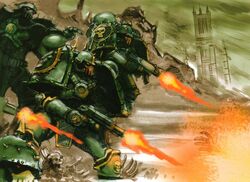
Death Guard Tactical Squad
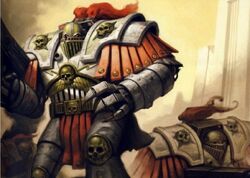
Death Guard Terminators in Cataphractii Pattern Terminator Armour before the Horus Heresy
Before they were reunited with their Primarch, the Dusk Raiders conformed very closely to the standard raiment of arms and organisational patterns laid out for the early Space Marine Legions by the Imperial Officio Militaris. At its most fundamental level the Dusk Raiders Legion was organised around the principle of equipping its individual Space Marines as well as possible, so that they could endure and prevail against any foe encountered and operate for extended periods without resupply or support if necessary. This dogma was the cornerstone of the XIV Legion's way of war, and was built upon the foundations of independence and surety with which the Dusk Raiders had always fought. The Dusk Raiders are noted in the Imperial records of this period as maintaining a well-rounded capacity for unleashing multiple modes of warfare, although with some bias towards heavy assault formations and attritional engagements, as evidenced by the particular use of close-ranged weaponry within the Legion. The Dusk Raiders Legion relied upon its infantry to provide its strategic strength, with the bulk of tactical fire support coming from heavily armed support squads, and later with considerable numbers of Terminators and Dreadnoughts providing reinforcement and an assault spearhead where needed.
Once Mortarion became the master of the XIV Legion the Death Guard changed dramatically, including its arts of warfare. Mortarion was at his heart an infantryman, and in his Death Guard he saw the chance to perfect the principle of the utilitarian warrior on foot who could go anywhere, fight on any ground and destroy any enemy through resilience, resolve and implacable aggression. As part of this doctrine, the Death Guard's squad formations were largely not static as in most Space Marine Legions of the time, but were formed, reformed and ordered as needed and as the given tactical situation required. To this end, a Death Guard Legionary was trained to be equally adept at any infantry role he might be called upon to perform on the battlefield rather than fighting at all times in a particular specialised role. In this way, a Death Guard Astartes would act as a Tactical Marine in one battle, a heavy weapons fire support specialist in another and so on, with only Techmarines and other highly specialised occupations remaining wholly dedicated to a single tactical role.
The Death Guard was organised around the principles established by the Dusk Raiders and built upon the ways they had always fought. Bolter, Melta and Flamer became the Death Guard's trinity of weapons around which their wargear was based, keeping supply needs to a minimum. Other types of ranged weapons were deployed sparingly only as the tactical situation or nature of the enemy demanded. Each Death Guard also carried a close combat blade as well, which included broad trench daggers,Warscythes and the heavy slashing Kukra native to Barbarus. Forged of dense black ceramsteel, these brutal and efficient weapons soon became the hallmark of the Astartes of the XIV Legion. This reliance on simple but effective tools of war was an outward manifestation of the cardinal belief held by the Legion that the Space Marine himself was the greatest of all weapons at the Imperium's disposal, a tireless engine of war before which any enemy would eventually succumb.
The Death Guard continued to rely throughout the Great Crusade almost exclusively on its infantry to provide its strategic strength, with the bulk of tactical support firepower coming from heavily armed support squads, and later from the Legion's considerable numbers of Terminators and Dreadnoughts, which provided reinforcement and assault spearheads where needed. This focus on heavy infantry formations was also one of the reasons the Death Guard Legion developed a particularly admirable record in fighting to clear Space Hulks of alien infestation and for their ability to destroy fortifications and citadels from within.
While the Death Guard did utilise field armour, support vehicles and transports (as Mortarion would not allow his forces to be circumvented, cut-off or left wanting for their lack), these were not given any primacy in the Legion's tactical doctrine. The only exception to this were dedicated siege units such as the Vindicator which was fielded in disproportionately high numbers by the Legion, alongside squadrons of Fellblade super-heavy tanks and Land Raider Spartans in mass warfare. It was notable in hindsight, and would prove to be a telling factor on Istvaan III, that a proportionately high number of the Death Guard Legion's war machine crews were still of Terran blood by the time of the Horus Heresy, while the heaviest infantry strike units, particularly the Legion's sizable core of Terminator Armour-equipped shock troops, were of Barbarus stock.
Unlike some of the Space Marine Legions whose operations were often diffused across separate commands, taskforces and campaigns spread across the galaxy during the Great Crusade, the Death Guard were accustomed to fight as a single, united force. As such, when the XIV Legion came to the Istvaan System at the start of the Heresy with almost its entire strength, the most accurate accounts of the time claim that the Death Guard maintained approximately 95,000 Space Marines, 70 capital ships and perhaps three times that number of smaller Escort and assault craft. With the conclusion of the bitter fighting on Istvaan III, it is estimated Mortarion's Legion had been reduced by well over 25,000 casualties, counting both the stubborn Terran Loyalists, betrayed to their deaths in the ash-mantled ruins of Istvaan III, and Mortarion's sons of Barbarus whose lives had been spent to purchase their demise.
It is believed that protracted fighting during the Istvaan III Atrocity had exacted a heavy toll on the Death Guard's armoured divisions, many of which had been amongst the suspected Loyalists within the Legion. Though it is believed many vehicles had been recovered from the planet, very little time had been available to render them fully battle-worthy again. However, the fighting that was to occur during the Drop Site Massacre engagement was to suit the Death Guard Legion well, with its strong emphasis and preference on attritional warfare and close order infantry tactics. Evidence suggests that a large core of Death Guard Legionaries deployed to one flank of the Urgall fortress-line, into a network of trenches, bunkers and slip-tunnels swiftly, but expertly, prepared or augmented by the Legion. This provided them both with deep protection from bombardment and hid their numbers.

Commander Ignatius Grulgor
Legion Command Hierarchy
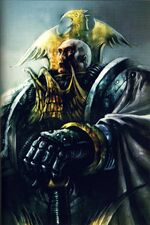
Battle-Captain Nathaniel Garro
When the newfound Primarch Mortarion was given command of the XIV Legion, he remade it as a single instrument of his will. Of all the Space Marine Legions, it was said of the Death Guard that they were but one entity with a single purpose and one body. The XIV Legion was re-ordered into seven "Great Companies" of considerably larger size than the standard Astartes Legion organisational structures of the Great Crusade era mandated. Obedience and order in the ranks of the Death Guard was absolute and an unbroken chain-of-command ran like blood in the Legion's veins. Legionaries were extensions of their sergeants' will, sergeants their captains', and captains their commander's, while collectively the Astartes of the Death Guard were all instruments of Mortarion, body and soul.
Few other ranks or divisions of formal organisation existed in the XIV Legion, except in very specialised, often technical roles. Each member of the Legion knew his place and the seniority and tasks of those around them without recourse to excessive heraldry and symbol. While many Legions had the tradition of giving the honorific of "First Captain" to the commanding officer of the elite 1st Great Company, the Death Guard also held two more privileged titles to be bestowed upon the commanders of the 2nd and 7th Great Companies, respectively. Thus, although they held no actual seniority over one another, the Captain of the 2nd Great Company could carry the rank of "Commander" if he so wished, just as the Captain of the 7th Great Company was known as the "Battle-Captain."
All Death Guard Astartes conformed to Mortarion's decree without rancour or dissent, and rivalries and internal strife were observed by outsiders to be few, particularly in comparison to more notably fractious Legions such as the Night Lords or Space Wolves. When an officer died in battle, his successor stepped into his place swiftly and decisively without need for orders or discussion, and so the Legion's chain-of-command was seamless even in the face of the heaviest losses, contributing to the Death Guard's reputation for endurance in war.
Specialised Ranks and Formations
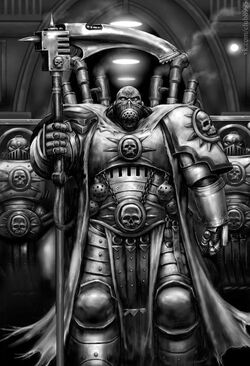
Primarch Mortarion and his personal bodyguard, the Deathshroud
- Deathshroud - The Deathshroud was an elite cadre of specially selected Battle-Brothers from the XIV Legion who served as Primarch Mortarion's mute bodyguards during the Great Crusade. Great secrecy surrounded this elite cadre, whose numbers were chosen from amongst the standard ranks of the Death Guard Legion from Astartes who had been singled out and personally selected by their Primarch for their bravery and valour. Once chosen, the selected Battle-Brother would give up his former life as a common rank-and-file Astartes and swear binding oaths of secrecy. A member of the Deathshroud would be listed as killed in action to allay any suspicions as to their true identity, and he would forever conceal his face by always wearing an enclosed helmet, mask or hood. The identity of each member of the Deathshroud was known only to Mortarion himself, even in the event of their death. The Deathshroud wore Artificer-crafted Terminator Armour of the highest quality, presenting a foreboding appearance with their barrel-chested appearance and like their Primarch, wielding large scythes called Manreapers. It was the Deathshroud's sacred duty to never stray more than forty-nine paces from Mortarion, with two Deathshroud warriors customarily escorting the Primarch at any given time, though there may have been more hidden in the shadows. These stoic warriors' presence was quite intimidating, as they stood uniformly at attention at all times, as still as statues. But in battle the Deathshroud would prove equally frightening, for whatever the odds, they always moved inexorably towards their target, almost as if they were automated killing machines.
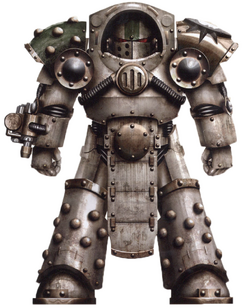
A Death Guard Grave Warden Terminator in modified Cataphractii Pattern Terminator Armour armed with an unidentified wrist-mounted Alchemical Weapon
- Grave Warden Terminator Squad - Originally used as an informal name for the variously armed battalions of Death Guard Terminators of Calas Typhon's company carried into battle aboard the unique Battleship Terminus Est, the term "Grave Wardens" also eventually became synonymous both within the Death Guard Legion and beyond it, specifically for the alchemical weapon-equipped Terminators unique to the Death Guard. Alone among the Legiones Astartes, the Death Guard made free and frequent use of alchemical weapons such as the crawling horror of Phosphex, inimically lethal Cullgene gas and flesh-eating Vasgotox fluid as a matter of course, and outfitted specialised units in modified patterns of Tactical Dreadnought Armour to disperse it accordingly. Where the Grave Warden Terminator Squads walked, they brought lingering, ugly death to whatever and whoever crossed their paths.
- Destroyer Squads - Considered dishonourable by some of the Space Marine Legions who made little use of them or eschewed them altogether, Destroyers were equipped with and expert in the use of otherwise proscribed and forbidden weaponry. Alongside certain factions of the Adeptus Mechanicus, only Destroyer cadres had the license to use these weapons in the forces of the Imperium by the Emperor's command. Rad-weapons, bio-alchem munitions and the burning horror of Phospex were amongst the forbidden weapons in a Destroyer Squad's dark arsenal, weapons which irrevocably tainted the ground upon which they were used. Marked by their fire-blackened and chem-scalded armour, Destroyers were often shunned and deemed somehow tainted by their fellow Battle-Brothers in many Legions and were considered at best a necessary evil, although the effectiveness of their relic-weapons in cracking especially difficult enemy defences could not be denied.
Recruitment
Attrition rates within the Death Guard Legion on active service were frighteningly high despite their legendary resilience. Indeed for many years of the Great Crusade only the World Eaters and Iron Warriors Legions were on occasion recorded to have spent more lives proportionate to their strength in pursuit of the Imperium's conquest. Barbarus itself in a short span of years became little more than a factory to produce new recruits for the Death Guard Legion, and intake from other sources of recruitment to which the Legion had title dwindled to a mere handful, unless the pressure of fatalities in the field proved too great. Mortarion's resistance to the use of bloodstock other than that of Barbarus wavered only because of the need to keep his Legion's strength battleworthy according to his own high standards. Recruitment solely from Barbarus was, however, aided by the high suitability of the planet's feral population for the Astartes conversion process.
Post-Heresy
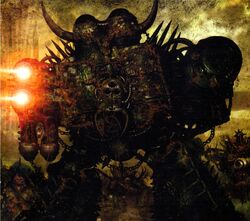
A corrupted Chaos Dreadnought of the Death Guard Legion
Following the Death Guard's corruption and Mortarion's ascension to daemonhood after the Legion took refuge in the Eye of terror following the Battle of Terra, the Legion began to splinter into smaller forces, although the Plague Marines still endeavour to organise themselves into multiples of seven, Nurgle's sacred number. What few vehicles remain to the Legion go unmaintained, sustained either by daemonic possession or controlled by packs of Nurglings.
Plague Marines
The members of the Death Guard are also known as Plague Marines. As a result of their servitude to Nurgle, they are rife with all manner of deadly diseases, which renders them immune to pain. In practical terms, this makes them harder to wound and kill than other Chaos Space Marines. While all members of the Death Guard are Plague Marines, not all Plague Marines are of the Death Guard Legion; other Chaos Space Marine armies may field Plague Marines as part of their forces.
Plague Marines under the tutelage of Mortarion know how to win a battle through sheer attrition. Because Mortarion intended for the Death Guard to rely heavily on infantry, the Death Guard are short some measure of fast assault vehicle and heavy weapons. As a result, Death Guard Astartes without Terminator Armour normally have to settle for special weapons such as the Melta Gun and Plasma Gun to replace heavy weapons such as Lascannons and Autocannons. Also, because the Death Guard are an infantry-based force, a Death Guard warband can be made up solely of Astartes with no armoured vehicles or daemons in its midst whilst still functioning as well as any other Chaos force that is better equipped. The average Death Guard Astartes can lay down a heavy rain of Bolter shells while still standing his ground if charged.
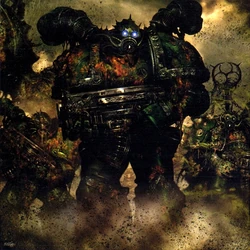
Plague Marines come forth, bringing death and destruction
Many Plague Marines, particularly those who were originally members of the Death Guard Traitor Legion, still prefer to wear the Mark III Iron Pattern suits of Power Armour first used during the Great Crusade. Even though more modern marks of Power Armour had become available to them before the Horus Heresy, the Death Guard retained a large stockpile of the heavier Mark III pattern, preferring it both for its durability and the ease with which they could customise it to better handle the rigours of the often-toxic battle zones in which the Legion excelled. The armour of Plague Marines, regardless of its type, usually suffers from severe corrosion and structural breaches over its millennia of service with a corrupted Astartes. Plague Marine Power Armour is often further modified with the inclusion of a heretical pattern "open vent" reactor backpack and blasphemous inconography as well as swelling or even cracking like a broken egg shell to contain the grotesquely mutated physique of its wearer.
Special Weapons and Wargear
What follows is a small selection of the unusual wargear and special abilities which can be used by members of the Death Guard:
- Nurgle's Rot - Nurgle's Rot is a virulent psychic power granted to some members of the Death Guard by Nurgle to use at will. The horrific plagues of Nurgle are summoned and unleashed upon the enemy. Those not tightly armoured are instantly affected, and quickly killed by the supernatural infection.
- Blight Grenades - Plague Marines also carry weapons known as Blight Grenades or Death Head Grenades. These grenades are made from the heads of conquered foes of Nurgle. Constructed by Nurgleite Chaos Sorcerers, the severed head is covered with a waxy mix of organic slime and contaminated blood until it is watertight. The brain cavity is then filled with pus and left to fester, becoming a poisonous gas. The result is a missile that bursts on impact, releasing a deadly acidic vapour laced with various pathogens that is capable of eating through most forms of personal armour.
- Manreaper - A Manreaper is a powerful Daemon Weapon that is a unique form of Power Weapon that pays homage to the Death Guard's Primarch Mortarion. Manreapers are carried by Chaos Champions of Nurgle, such as Typhus the Traveller. The weapon often takes the shape of a large Power Scythe, enabling a warrior to face many times their number in battle, cutting them down like a reaper through a field of ripe crops. Manreapers are also covered in a corrosive poison that contains a vicious toxin, allowing the bearer to wound his opponents with ease.
- Plague Knife - The hallmark weapon of the Death Guard was their close combat blade, a broad trench dagger, which was a brutal and efficient weapon in hand-to-hand combat. When Astartes of the Death Guard were transformed by the corrupting influence of Nurgle, these blades transformed as well. Now they have become Plague Knives, corroded weapons coated with rust and numerous diseases, the better to spread Father Nurgle's vile blessings across the galaxy. Only those pure in his sight such as his Plague Marines are granted such a weapon, and any lesser being suffering even the slightest wound is gifted with one of his innumerable creations such as Nurgle's Rot or the Weeping Pox.
- The Destroyer Hive - The Destroyer Hive is a vile ability only available to Typhus, the "Herald of Nurgle". It is a monstrous swarm of plague-infested flies, so numerous they blot out the sun and flood the air surrounding Typhus with contagions. It was the prize granted to Typhon when he delivered the Death Guard to Nurgle, his very body now transformed into a host for this innumerable horde of Nurgle's sacred animals.
Legion Combat Doctrine
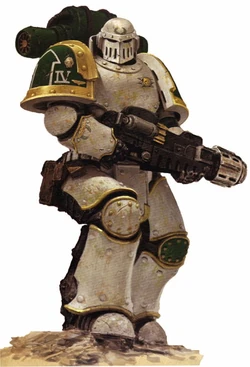
A Death Guard Legionary during the Great Crusade
When the XIV Legion was still known as the Dusk Raiders, its Astartes signature strategy had been to attack their foes at nightfall, thus earning them their Legion moniker. The Dusk Raiders' Power Armour was an unpainted slate grey in colour while their right arm and one or both shoulder plates were painted crimson. This was done with the intent to symbolically show their enemies what they truly were -- the Emperor's red right hand, relentless and unstoppable. Many enemies would throw down their weapons the moment the sun dipped beneath the horizon rather than dare to fight them.
With the coming of Mortarion, the Legion's combat doctrines changed as the Death Guard became a single instrument of his will. The Death Guard came to believe that victory came through sheer relentlessness. Their weapons, while not ornate, functioned without flaw. They did not manoeuvre in fanciful patterns to confuse the enemy, instead they stood their ground and waited for the enemy assaults to falter before striking back with fatal force. Any environment or situation Mortarion and his advisors could not compensate for, the Death Guard would overcome through sheer stubborn resilience and painful endurance. Mortarion had learned the art of warfare on a world almost covered in mountainous terrain, and even though his innate intellect allowed him to grasp the proper use of tanks and armoured vehicles, the primacy of the foot soldier remained the Death Guard's trademark. Each Space Marine was well-trained in a variety of infantry disciplines, and was able to function in almost any role or environment.

Loyalist Death Gaurd Astartes fight desperatly alongside Imperial Fist marine's against Chaos plague forces
After the Death Guard was transformed by the Plague Lord and turned into a Legion of Plague Marines, they preferred to engage in short-ranged firefights, where they could see the festering wounds inflicted upon their enemies whilst they shrugged off the bolts and las-blasts directed back at them. Their decaying brains are inured to the agony of the bodily corruption that runs rampant in their diseased carcasses, making them all but immune to the pain or discomfort caused by battle wounds. When their enemies close within assault range, Plague Marines make use of their Blight Grenades and release the virulent toxins that they contain, which proceed to eat away at armour and fill the air with thick noxious clouds of blinding, pathogenic spores. The most virulent and flamboyant of these Blight Grenades are made from the severed, decaying heads of their fallen enemies.
Fearful Weapons
It is of note that the Death Guard under Mortarion quickly became associated with the use of alchem and radiation weaponry to a greater extent than any other Legion, further darkening their reputation with the Battle-Brothers of the other Legiones Astartes. Simply put, the use of toxic gas, burning Phosphex and contaminated rad-shells did not rankle their Legion's honour as it did for some, while Mortarion himself was a master of the use of such weapons of mass destruction and a student of the most horrific arts of war, and had no compunction in their use against any foe that threatened humanity. The Death Guard Astartes' inherent resilence to toxins and poisons enabled them to be deployed to warzones afflicted by the most hellish and lethal conditions, be they atomic, bateriological or chemical in nature, and in which they would then excel. The Great Crusade was, after all, launched to conquer worlds and not destroy them, unless there was no alternative, but in such warzones, already hopelessly contaminated and unsuited for human life, the usual caveats and protocols restricting the use of contaminate weapons by the Emperor's command did not often apply.
Legion Homeworld
Barbarus was a Feral World which orbited near its dim yellow sun in the Segmentum Tempestus, which created a thick, miasmic atmosphere of toxic chemicals. The most virulent of these gases rose through Barbarus' perpetual clouds towards the heat of its star, making the world beneath a dismal place of night, unbroken by starlight and with short, shadowy days. An atmosphere breathable by humans existed only in the lowest elevations, on flat moors and in the valley basins of the jagged, stony mountains which spined the world. Unknown alien beings immune to the toxic soup of the planet's higher atmosphere existed on Barbarus, building great keeps of grey stone in the mountain fastnesses. When humans first settled Barbarus, the horrific environmental conditions from which they had to eke out survival quickly reduced them to a pre-feudal state. The higher beings' incomprehensible Warp-based powers, their ability to survive where men could not, and above all their hunger to prey upon, experiment with and accurse humankind, caused the settlers to ascribe to those beings a medieval supernaturalism. The true nature of these dark overlords, beyond their obvious connection to the dark entities of the Empyrean, will likely never be known.
Barbarus is assumed to have been destroyed by an Exterminatus order issued by the Inquisition after the end of the Horus Heresy, like all the other worlds belonging to the Traitor Legions. Mortarion has crafted a new home from a Daemon World called the Plague Planet within the Eye of Terror, which resembles ancient Barbarus in many regards. Human slaves are kept in villages below the poisonous mists of the world, while the Plague Marines and other servants of Nurgle reside in fortresses constructed on the mountainsides.
Legion Beliefs
The beliefs of the Death Guard before the outbreak of the Horus Heresy echoed those of their Primarch. At the heart of their core beliefs before the Heresy was the unshakeable determination that Mankind should be free of oppression and terror. Such freedom could only be won by destroying those that would shackle and devour humanity. The battle for the future of Mankind was one that could only be achieved through the endurance of any hardship, no matter how terrible. The liberation of humanity justified the ultimate use of any means. The Death Guard's faith in inner strength, iron will and unshakeable resolution in the face of hardship led to overweening pride, arrogance and an utter contempt for those they deemed inferior. When Nurgle's Rot laid the Death Guard low during their time trapped in the Warp, their pride and arrogance in their strength and contempt for those they deemed weak was laid bare. The Plague Marines' subsequent surrender to Nurgle left the Death Guard with an incredible depth of self-hatred and despair that only fuels their sole desire: to infect the strong, slay the weak and bring everyone and everything to rot and ruin. In their eyes, their own debasement would no longer seem as shameful if Nurgle's pestilence dragged the rest of the galaxy down into the same depths of ruin and despair.
Cult of Personality
The arrival of the Primarch Mortarion's within the XIV Legion in the later days of the Great Crusade seemed to augment and amplify characteristics that had always been present in the Dusk Raiders to new and unseen extremes, while other aspects of the Legion's established nature fell away like a shed skin. Mortarion possessed a razor-sharp intelligence and flare for organisational simplicity and efficiency. These factors, coupled with the ability to inspire a fanatical loyalty in those of Barbarus blood who viewed him as no less than a near-divine saviour, engendered a fanatical loyalty to its Primarch rarely seen in other Legions. It was no wonder then that by the time of the Istvaan III Atrocity, with the majority of the Legion being of Barbaran bloodstock, that their loyalty was to their Primarch first, then their Legion and to Horus. The majority of the Barbaran-born Death Guard Space Marines were more than willing to spit upon their oaths of fealty to the Emperor of Mankind and cast their lot with their macabre Primarch when the time came, a decision which ultimately encompassed the XIV Legion's doom.
Number Seven
When Mortarion reorganised the XIV Legion's organisational structures he reorganised them into seven Great Companies. The number seven and its derivations seemed to hold occult and ritual significance both to Mortarion and the Barbaran culture of his blighted world of adoption. Notionally each company was to hold some 70,000 Space Marines, meaning that the desired total strength of the Death Guard Legion was some 490,000 Astartes, although in reality nothing approaching this number was ever achieved. Attrition and bloodshed, as well as the constraints of time and Imperial resources, were to ensure that the XIV Legion never reached this number but the figure remained, if nothing else, a measure of Mortarion's ambition.
Battle Damage
The Death Guard cared little for emblems of rank, except where needed for battlefield recognition. Nor did the Astartes of the Death Guard care for badges of honour or other trinkets to commemorate deeds of valour. The closest the Space Marines of the Death Guard came to such decoration was respect for the marks of battle itself on their armour, be they from an enemy's blade or bullet, or the corrosive stains of a toxic environment none but the Death Guard could have endured. So long as the integrity of the armour plate itself was not compromised, such damage was left to adorn a Death Guard Space Marine's armour as a statement that there was nothing they could not endure, adding to the XIV Legion's increasingly sinister appearance and deepening reputation among their fellow Astartes during the Great Crusade.
The Cups
Often, a Battle-Brother of the Death Guard would be singled out by Mortarion, who would then offer the selected warrior the rare opportunity to share a celebratory drink with him. It was said that there was no toxin too strong, no poison so powerful and no contagion of such lethality that a Death Guard could not resist it. The Death Guard were known to harden themselves through stringent training regimens as Neophyte Astartes, willingly exposing themselves to chemical agents, contaminants, deadly viral strains and venoms of a thousand different shades. They could resist them all. From a set of bowls was mixed and poured dark liquids into a pair of ornate goblets. The senses of the chosen Astartes often rebelled against the odour of the toxins, their implanted Neuroglottis and Preomnor organs rebelling at the mere smell of the poisonous brew; but to refuse the cup would be seen as weakness. The poured distillate often contained a potent mixture of agent magenta nerve bane, some variety of sword beetle venom, and other, less identifiable compounds. The cups were Mortarion’s, and in each battle where the Death Lord took to the field in person, he would select a warrior in the aftermath and share with that man a draught of poison. They would drink and they would live, cementing the unbreakable strength of the Legion they embodied.
Mortarion understood that many within the Legion frowned upon such traditions as The Cups, but the Primarch knew that honours and citations were sometimes necessary. Warriors needed to know that they are valued. Praise from one’s peers must be given when the moment was right. Without it, even the most steadfast man would eventually feel unvalued.
Legion Warcry
The Death Guard have no warcry, believing that like plagues and pestilence, death should come silently. Before the Heresy the Astartes of the XIV Legion would shout "For Terra and Mortarion!" when they entered the fray and the 7th Great Company in particular used the cry "Count the Seven!"
Notable Death Guard
- Mortarion - Also known as the Death Lord or the Prince of Decay after he turned to Chaos, Mortarion was one of the original twenty Imperial Primarchs created by the Emperor of Mankind. He was given command of the Death Guard Space Marine Legion on the arrival of the Emperor to his homeworld of Barbarus, but he turned to the Forces of Chaos during the Horus Heresy. At present, Mortarion is the greatest Daemon Prince of Nurgle and the Daemon Primarch of the Death Guard Chaos Space Marines.
- Typhus the Traveller (formerly First Captain Calas Typhon) - The first Astartes of the Death Guard to turn to the service of Chaos in his desire for power, Calas Typhon, once the First Captain of the Death Guard's 1st Great Company and the second greatest Astartes in the Legion after the Primarch Mortarion, is now known as the Herald of Nurgle and the Host of the Destroyer Hive, perhaps the most terrible of the many pestilences unleashed on the universe by Nurgle. He is still in command of the powerful the Chaos Battleship Terminus Est, which has been under his control since the Battle of Istvaan III during the Horus Heresy, though it has been much warped by the power of Chaos and the Plague Lord since those long-ago days 10,000 years ago.
- Commander Ignatius Grulgor - Captain of the 2nd Great Company. During the massacre on Istvaan III Grulgor was posted on the Eisenstein to kill Captain Garro and the hundred strong company of Astartes with him. Was killed for the first time in a firefight in the gun decks of the Eisenstein, after a stray bolt pistol shot released the Life-Eater virus intended to be fired on Istvaan III. After the Escape of the Eisenstein and the following Warp journey, the body of Grulgor was reanimated by the Ruinous Powers as one of the very first Plague Marines ever encountered by the Imperium. After a desperate battle, Grulgor's mutated body was destroyed when the Eisenstein made an emergency transition back to realspace and the Plague Marines' connection to their patron Nurgle's domian was suddenly extinguished, causing their souls to be returned to the Realm of Chaos. However, it is likely that Grulgor survived these events as a newly transformed daemonic spirit, for a Nurgleite Daemon Prince known as Grulgor led the Forces of Chaos during the Fall of Medusa V campaign in the late 41st Millennium.
- Ullis Temeter (Presumed Deceased) - Temeter was the Captain of the 4th Great Company of the XIV Legion. Temeter remained loyal to the Emperor, despite the spread of corruption throughout his Legion. He met his ultimate fate on the surface of Istvaan III. When Saul Tarvitz of the Emperor's Children brought warning of the Warmaster Horus' treachery, Temeter and hundreds of Loyalist Astartes sought cover as Horus ordered the viral bombardment of the planet. Thanks to Tarvitz's last minute warning, some of the Loyalist forces were able to take cover in air tight bunkers. Temeter, along with his fellow Loyalist captains from the Luna Wolves, Garviel Loken, Tarik Torgaddon, and Tarvitz, managed to turn the rag-tag Loyalist survivors of Istvaan III into a cohesive fighting unit. Tarvitz was instrumental in turning a planned massacre into a successful guerrilla war, confounding even the great Horus' best laid plans. Temeter, along with his fellow Loyalists, apparently met their final fate on Istvaan III after Horus tired of the conflict and ordered an orbital bombardment of the world's capital, the Choral City.
- Battle-Captain Nathaniel Garro - Nathaniel Garro was the Battle-Captain of the Death Guard's 7th Great Company. Leader of the 70 surviving Astartes who alone of the Death Guard Loyalists escaped the betrayal of Horus on Istvaan III aboard the Imperial Navy frigate Eisenstein to bring word of Horus' betrayal to the Emperor. He held to the original tenets of the Legion when many of his Battle-Brothers chose to follow the Traitors, Horus, Mortarion, and First Captain Typhon's decision to serve Chaos and conquer the Imperium for themselves rather than trust in the will of the Emperor. After a lucky rendezvous with the Imperial Fists' space fortress Phalanx, news of Horus' treachery was brought to Terra and the Emperor, which could well have saved the Imperium. While his historical fate is uncertain, it is believed that Garro, along with the remaining Loyalist Luna Wolves Astartes, Iacton Qruze, was ordered by Malcador the Sigillite to gather 8 Astartes from both the Loyalist and Traitor Legions across the galaxy. who would later form the precursor of the Grey Knights Chapter of Space Marines, and along with 4 lords and administrators of the Imperium would forge the secret organisation that would later became the Imperial Inquisition. After arriving on Terra, Garro's Power Armour had all of its Death Guard regalia removed and replaced with the personal sigil of Malcador, an "I" with three horizontal lines through its center, the icon that would later become famous as the Rosette of the Inquisition. During his mission for the Sigiliite, Garro consistently referred to himself as a "Knight Errant" and the member of a "Legion of One." Garro wields the potent relic Power Sword called Libertas.
- Marshal Durak Rask (Deceased) - Durak Rask was a fanatical follower of his Primarch, viewing Mortarion as a preternatural saviour from his early youth on the benighted world of Barbarus. Accepted into training for the Death Guard Legion, Rask was marked from an early age for his innate intelligence and fervour. He quickly proved to be a dour and driven warrior with an uncommon flair for siegecraft. He soon rose over his decades of service to become the Legion's Marshal of Ordnance, and proved his mettle in many battles and campaigns. When Mortarion declared his allegiance for Horus at the start of the Heresy, Rask was one of the first and loudest in his support, having already become a member of the Seven Pillared Lodge which had been founded within the Death Guard as a warrior lodge to corrupt them towards the service of Chaos from within. On Istvaan III Rask volunteered to lead the vanguard attack against his former Battle-Brothers, a treachery he would pay for with his life.
- Solun Decius - Decius was a member of the 7th Great Company commanded by Battle Captain Nathaniel Garro, and the youngest member of Captain Garro's command squad. Brother Decius remained loyal to Garro, despite the corruption that had begun to creep into the Space Marine Legions under Warmaster Horus' command, in the form of the warrior lodges. Garro expressed his disapproval of the secretive lodges and so, Decius chose not to join the warrior-lodge that existed inside the Death Guard when offered membership. Being a part of Garro's command squad, he was aboard the Eisenstein when his Captain took control of the vessel and fled the Isstvan system in an attempt to bring word of Horus' treachery to Emperor. Enroute to Terra, Decius and a number of his fellow Death Guard fought a battle against the reanimated corpses of their former traitorous comrades, the first Plague Marine of Nurgle. Decius was grievously injured when he was stabbed by one of the Plague Marine's deceased knives, and in a vain attempt to halt the vile corruption, he bravely cut off his own arm. The severely wounded marine was then taken to the Apothecarion and put under the care of Apothecary Voyen, but alas, there was no cure to be found to ease young Decius' suffering. After completing their arduous journey and delivering their message to the Emperor's acting Regent, Malcador the Sigillite, Garro and his men were placed under house arrest and held in solitary confinement in a fortress on Luna, under the watchful eyes of the Silent Sisterhood. Their fate was yet to be decided. In the meantime, the mortally wounded Decius finally lost his fight to the Nurgle's Rot that ran rampant throughout his deceased and corpulent form. Giving himself fully to Father Nurgle, Decius' body metamorphosised into the mutated form of the daemonic entity, known as the Lord of the Flies. His twisted body took on a daemonic appearance; arachnid-like head with numerous eyes and mandibles in place of its mouth, his decapitated arm growing grotesquely into a large power claw-like, great skeletal hand. The Lord of Flies wrecked havoc inside the fortress killing two former comrades before Captain Garro strode forth and slew the monstrosity outside the fortress on Luna's surface, casting the Lord of Flies' daemonic spirit back into the Warp from whence it came.
- Meric Voyen - Meric Voyen was the company Apothecary of the 7th Great Company commanded by Battle-Captain Nathaniel Garro. Garro was furious with Voyen when the Apothecary confessed that he was a member of the secret warrior lodges that had begun to spring up in the XIV Legion. Garro let it be known to his men that he did not approve, for he felt that these lodges, though they had their worth, were ultimately predicated upon secrecy and the act of concealment which were anathema to the Astartes, and he would take no part in it. He later pulled Voyen aside and confronted him in private. Though he formally censored the Apothecary for being a member of the warrior lodges, he made the Apothecary swear to him that he would never keep any secrets from him. Voyen readily agreed, but knew in his heart that it would take much to regain his commander's trust. During the Istvaan Campaign, Garro’s 7th Great Company fought in concert with the Emperor's Children’s elite 1st Company against traitorous forces on Istvaan Extremis, the outermost planet within the Istvaan System. Whilst fighting against a powerful Slaaneshi psyker known as a Warsinger, Garro sustained serious injuries that included crushing damage to his torso, arm and the loss of his right leg from the mid-thigh down. He was only saved from certain death by the timely ministrations of an Apothecary from the Emperor’s Children Legion -- their Chief Apothecary Fabius -- much to Voyen's displeasure. The Legion’s Apothecaries had not declared him fully healed and therefore Garro was deemed unfit for battlefield operations. His command also remained on limited duty until Garro was fit to reenter combat. As a result, Garro and his company were not among the Death Guard Loyalists assigned to unleash the speartip assault upon Istvaan III, so they remained aboard the Frigate Eisenstein providing standby tactical support for the Drop Pod deployment operation, and remained on alert to perform rapid-reaction interdict duties. Before the mission began, First-Captain Calas Typhon pulled Commander Ignatius Grulgor, the Captain of the 2nd Great Company, aside and spoke to him of their Primarch’s desire to bring Garro to Horus' banner over the Emperor's, but they both knew that Garro would never betray the Master of Mankind. When the turning point arrived, Typhon informed Grulgor that there were certain duties that Horus would want him to perform. The Commander relished his part in this conspiracy against Garro, whom he had long found insufferable. Aboard the Eisenstein, suspicious of Commander Grulgor's actioins, Apothecary Voyen stealthily made his way to the launch bay to investigate. Voyen saved Garro's Housecarl Kalab from narrowly being captured by Grulgor’s men. Kalab shared with Voyen that he had seen Grulgor and his men loading an unusual cargo aboard the frigate. Digesting what the housecarl told him, Voyen realised with growing horror that the deadly cargo were Life-Eater virus bombs – biological weapons that contained an engineered viral strain of such complete lethality that it could only be deployed in the most extreme circumstances, usually against the most foul xenos. Informing his commander of Grulgor's actions, Garro decided to confront the treacherous commander. With only Apothecary Voyen, Battle-Brother Sendek and his housecarl, Garro confronted Commander Grulgor and his entire command squad and a handful of the frigate's crew. A vicious fight ensued and Garro and Voyen narrowly avoided death. Grulgor and his men suffered the lethal effects of the Life-Eater pathogen when it was accidentally released by a stray Bolter round that punctured one of the warheads, and Grulgor and his men died screaming in agony. During their flight to Terra to bring warning to the Imperium of the treachery of Horus, Voyen second-guessed his commander's actions multiple times, but ultimately, Garro's desperate gamble of detonating the Frigate's Warp engines when they became trapped in the Warp and were under assault by the undead Plague Marines of Nurgle, paid off. They were rescued by the Primarch Rogal Dorn and his Imperial Fists Legion. Aboard the Phalanx, they brought word of Horus' treachery to his stern brother. The Imperial Fists brought Garro and his men to Luna, where they were imprisoned within the Somnus Citadel of the Silent Sisterhood. One of Garro's men, Solun Decius, finally succumbed to the mysterious contagion he had contracted when the Loyalist Death Guard were confronted aboard the Eisenstein by the reanimated corpses of Grulgor and his men -- the first true Plague Marines. A vicious battle ensued, and Garro was able to destroy the Chaos-tainted daemon that had possessed Decius' tortured body. Following this final battle, Voyen informed Garro of his intentions to renounce his oaths as a warrior in order to dedicate his life to healing and the discovery of a cure for the mysterious contagion contracted by Decius, which was later identified as the first known case of Nurgle's Rot.
- Crysos Morturg - Section Leader Crysos Morturg was a bitter warrior, morbid and given to introspection. He was disliked by his Battle-Brothers despite his evident talents as a warrior and field commander. He was neither Terran nor Barbaran by birth, having been inducted into the Death Guard Legion during an emergency influx of recruits from the induction pool of the 18th Expeditionary Fleet after the Death Guard suffered near-catastrophic losses during the Rangda Xenocide campaign of the Great Crusade. Years after his induction, after he rose to the rank of Lieutenant, his latent psychic abilities manifested. This only served to further isolate him from his fellow Astartes, and he had barely begun his training within the Legion Librarius when Mortarion had it disbanded and ordered such "witchcraft" suppressed. Morturg was reassigned to the Legion's Destroyer Corps and was often given Legionaries judged to be fractious or unstable, and his unit was tasked to the brunt of the worst fighting the Death Guard endured. During the campaign against the Traitor Legions' Loyalists on Istvaan III at the start of the Horus Heresy, he was marked for death and sent to the surface on the doomed world. But Morturg did not die and instead endured, rising to become one of the most deadly commanders of the Loyalist resistance. Despite all the odds, Morturg survived the atrocity on Istvaan III and he and the few remnants of the slaughtered Loyalists he had gathered to him would live to avenge themselves upon their former brethren.
- Loyalist Legionary Kalaeb Molor - Kalaeb Molor fought as part of a resistance group under the command of Crysos Morturg and was valiantly slain in battle against the Traitor forces of the World Eaters Legion.
- Loyalist Sergeant Sorruk Vasha - Vasha was a Tactical Squad Sergeant of the Death Guard's 4th Great Company who took part in the initial assault wave sent against the rebels of Istvaan III, and owing to damage sustained by his Power Armour during the battle, Vasha perished to the ravages of the Life-eater virus during the initial bombardment by the Traitors which unleashed the Istvaan III Atrocity.
- Ancient Lhorgath - Ancient Lhorgath was once the commander of the 14th Chapter, 2nd Great Company of the Death Guard Legion, a rank he reluctantly set aside upon being mortally wounded battling the Fane-Kings of Narbasi during an Imperial Compliance action. At the Istvaan V Drop Site Massacre, Ancient Lhorgath led his Dreadnought Talon in a fearsome counter-charge into the midst of the Salamanders Legion in the battle's bloody final hour; it is claimed Lhorgath was struck down by Vulkan himself in the desperate fighting. Lhorgath's Contemptor Pattern Dreadnought chassis was an exemplar of the prototypes of the type delivered to the Death Guard Legion's armouries which were subjected to numerous repairs and modifications by the Legion's Artificers.
- Kahgor Lothsul - A Veteran Death Guard Space Marine Legionary and Warrior Lodge member who was mortally wounded fighting Ork marauders on the world of Huashta a little less than a standard year before the Istvaan III Atrocity. The fight on Istvaan III would be his first and last battle for his Legion in his Contemptor Pattern Dreadnought chassis. Operating as part of a hunter-killer detachment during the heights of the ash storms that engulfed the Choral City after the firestorm unleashed by the Life-eater virus bombing, Lothsul was ambushed and destroyed by Ordo Reductor Thallax forces, and his remains scavenged before they could be recovered by Death Guard counter-attack.
- Ancient Skorrvall "Bitterblood" - Skorrvall was the commander of the Death Guard's 7th Dreadought Talon. Skorrvall was a native of Barbarus from that world's intake into the Death Guard Legion and was known as a darkly-tempered warrior and a survivor against the odds. Rising to the honoured rank of Standard Bearer of the 19th Chapter of the Death Guard's 1st Great Company, he was mortally wounded in battle with the Eldar at Neverlight and interred in a Dreadnought frame. Fighting with the Traitors in Mortarion's Vanguard at Istvaan III, he killed indiscriminately during the "Veil of Grief" incident and was badly damaged by cannon-fire but survived to later take part in the Drop Site Massacre at Istvaan V.
- Necrosius - Necrosius was once an Apothecary of the Death Guard Legion during the Great Crusade whose original name has long been purged from all Imperial records. During the early days of the Horus Heresy, soon after the Death Guard turned against the Emperor of Mankind, when the Traitor Legion's fleet was becalmed in the Warp on the way to Terra and assaulted by the infectious corruption of Nurgle, the man who would become Necrosius the Undying and his fellow Apothecaries among the Astartes of the Death Guard turned their every art and skill against the strange plagues sweeping their ranks. But it was all to no avail. When Necrosius heard the voice of his new lord chortling and whispering to him in the murmerous wings of carrion flies and the sibilant gurgling of rotted, decaying organs, he fully accepted the nightmare truth of what he and his fellows had become, and embraced the service of his vile God. Necrosius became a true convert to Nurgle's cause, casting aside his past learning and cherished role as a healer of his Battle-Brothers. He now chose to give himself, blighted soul and rotted body, to the lore of death and the pursuit of daemonic sorcery, and soon excelled as a master of the dark arts of necromancy. Now this bitter and twisted Chaos Sorcerer is Nurgle's sworn servant and the master of the warband of Chaos Space Marines known as the Apostles of Contagion.His dark arts of necromancy can awaken the dead to a nightmarish half-life, unleashing the Zombie Plague of the Plague Lord upon friend and foe alike.
- Blight-Master Ussax - Ussax is a Veteran of the Death Guard, and known as a member of the inner circle of Chaos Sorcerers that serve the Daemon Primarch Mortarion. He is well known to the Ordo Malleus and to the Grey Knights, and has been responsible for countless millions of deaths throughout the millennia. Ussax is held to be one of the most darkly gifted concoctors of blights, afflictions and plagues serving the Death Guard, and his recent appearance in the warzones of the Jericho Reach, attended by a cadre of Plague Marines, is a cause for much concern amongst those with knowledge of his capabilities. According to recent findings presented to the Chamber of Vigilance of Watch Fortress Erioch, Blight-Master Ussax has been present in the Reach for around three standard years, travelling from one warzone to the next. At each battlefield, he gathers up a grim and unspeakable harvest from the dead and the dying, before returning to some as yet undiscovered fastness to concoct his latest ague. This he then unleashes upon the next battlefield he attends, once more harvesting the bodies of the victims. It is feared that the Blight-Master is refining his plagues, using the raging conflicts of the Jericho Reach as some vile breeding ground for new agonies to unleash upon an unsuspecting galaxy in Father Nurgle's name.
Legion Fleet
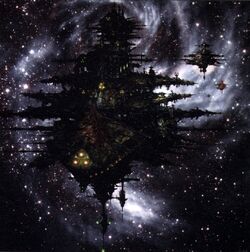
Death Guard Legion fleet
Although not as numerically large as the dedicated warfleets of certain Legions (notably the Imperial Fists, Sons of Horus and Dark Angels), the Death Guard possessed a high proportion of heavy capital ships, many of which were not only of considerable size and power but in several cases unique, being relics of the lost Dark Age of Technology. The names of these vessel had entered into legend well before the Great Betrayal and would live on in infamy long afterward. The following vessels were known to belong to the Legion fleet of the Death Guard before and during the Horus Heresy:
- Endurance (Goriana-class Battleship) - The flagship of the XIV Legion and the Primarch Mortarion during the Great Crusade and Horus Heresy.
- Indomitable Will (Capital Ship, Unknown Class)
- Lord of Hyrus (Captial Ship, Unknown Class)
- Plagueclaw (Capital Ship, Unknown Class) - The Plagueclaw was a vessel known to be present in the Death Guard's Legion fleet after they were corrupted by Chaos. It may originally have been a different vessel, even one of those named here, and been renamed after the Death Guard swore its allegiance to Nurgle.
- Spectre of Death (Capital Ship, Unknown Class)
- Terminus Est (Capital Ship, Unknown Class) - The Terminus Est was the flagship of First Captain Calas Typhon and remains his vessel today now that he has become Typhus, a Chaos Lord and the Herald of Nurgle, though the vessel has become as twisted and unrecognisable as its master.
- Undying (Capital Ship, Unknown Class)
- Reapers' Scythe (Battle Barge)
- Fourth Horseman (Battle Barge)
- Stalwart (Battle Barge)
- Mia Donna Mori (Battleship) - During the Great Crusade and the Horus Heresy this goliath Battleship was a notable engine of destruction and was known to carry enough Exterminatus-class alchem and bio-kill weaponry within her armoured vaults to end life in an entire sector if unleashed.
- Barbarus' Sting (Strike Cruiser)
- Eisenstein (Frigate) - The Eisenstein was destroyed in the course of its famous flight to bring word of the Warmaster Horus' betrayal to the Emperor on Terra at the direction of Nathaniel Garro.
- Valley of Haloes (Supply Hauler) - The Valley of Haloes was a supply hauler in service to the XIV Legion during the Great Crusade. Suffering a dangerous Gellar Field fluctuation while in transit to the Death Guard’s 6th Company flotilla at Arcturan, the Valley had emerged from the Immaterium to effect emergency repairs. Unfortunately the Valley of Haloes was a casualty at the Arcturan engagement, lost with all hands. Fortunately, a distress signal and recording of the recent outbreak of insurrection against the Imperium within the Isstvan System was received and conveyed to the Terminus Est before this regrettable event.
Legion Appearance
The Chaos Space Marines of the Death Guard often wear the antique Mark III Iron Pattern of Power Armour as it was particularly useful in providing enhanced protection in the toxic environments that the XIV Legion preferred to fight in.
Legion Colours
As the Dusk Raiders, the XIV Legion's armour was an unpainted storm grey. The entire right vambrace, gauntlet and shoulder plate (sometimes both) were painted the deep crimson of drying blood, which signified the XIV Legion's status as the "red right hand" of the Emperor's justice. After their Primarch Mortarion took command of the XIV Legion, the newly redubbed Death Guard began wearing ivory-grey unpainted ceramite, save for a few murky-jade coloured markings. After their acceptance of Nurgle as their patron, the Death Guard's armour has taken on a sickly green appearance. Plague Marines are known for having many boils, sores, and open wounds visible on their bodies, and the more mutated often sport tentacles or the trademark single horn commonly seen on minions of Nurgle. The helmets of Plague Marine Power Armour often resemble old-fashioned gasmasks, particularly those of Russian or German make during the two World Wars, in reference to the poison mists of Mortarion's homeworld, Barbarus. Mortarion, with his pale skin, huge scythe and hooded robes, bears a great resemblance to classical representations of the Grim Reaper, the embodiment of Death himself.
Legion Badge
The Dusk Raiders' Legion badge was a black skull halved, with a setting black sun on the other side, centred on a field of deep crimson. This icon symbolised the XIV Legion's given epithet of the "Dusk Raiders," a consequence of their use of the ancient tactic of conducting major ground attacks at the fall of night. Once the Dusk Raiders were unleashed upon their foes, nothing would stay the Legion's hand. Before the Horus Heresy, the Death Guard's badge was a green skull within a sunburst icon. After the Heresy, when they accepted the Plague Lord as their patron Chaos God, the Legion has chosen to wear the Mark of Nurgle as their Legion badge.
Sources
- Apocalypse (Supplement), pp. 171-172
- Codex: Chaos Space Marines (6th Edition)
- Codex: Chaos Space Marines (4th Edition)
- Codex: Chaos Space Marines (3rd Edition, 2nd Codex)
- Codex: Chaos Space Marines (3rd Edition, 1st Codex)
- Codex: Chaos (2nd Edition)
- Codex: Eye of Terror (3rd Edition), pp. 9, 17
- Deathwatch: First Founding (RPG), pp. 84-85
- Horus Heresy: Visions of Death by Alan Merrett
- Imperial Armour Volume Seven - The Siege of Vraks - Part Three
- Index Astartes III, "The Lost and the Damned - The Death Guard Legion"
- Realm of Chaos: The Lost and the Damned
- Imperial Armour - The Horus Heresy - Book One: Betrayal, pp. 120-137
- Warhammer 40,000 Rulebook (6th Edition)
- White Dwarf 303 (US), "Crux Terminatus - Plague Marines", pp. 24-29
- White Dwarf 291 (US), "Plague Bearers: Death Guard Fiction" & "Tactica Death Guard"
- White Dwarf 282 (AUS), "Heroes and Villains of the 41st Millennium – Typhus, Herald of Nurgle"
- White Dwarf 264 (US), "Index Astartes (First Founding): The Lost and the Damned - The Death Guard Space Marine Legion", pp. 68-75
- White Dwarf 204 (US), "Plague Marines: Chaos Plague Marines of Nurgle", pp. 33-35
- Galaxy in Flames (Novel) by Ben Counter
- The Flight of the Eisenstein (Novel) by James Swallow
- Fulgrim (Novel) by Graham McNeill
- A Thousand Sons (Novel) by Graham McNeill
- The First Heretic (Novel) by Aaron Dembski-Bowden
- Prospero Burns (Novel) by Dan Abnett
- Pandorax (Novel) by C.Z. Dunn

